
24 Kiwifruit’s Pacific friendly 28 Cherry UFO success 48 Optimism for organics Woody debris
a worry Page 15 VOL 96 | NO 09 | OCTOBER 2023 In this issue
still
Optimised two-way systemic activity, delivered by a class leading formulation.
• Optimised formulation gives unparalleled penetration
• Unrivaled and proven efficacy
• Proven crop safety

• Soft on key beneficials Movento 100SC - for results you can trust.

BAC 2894
with
in
We’re
you
the field cropscience.bayer.co.nz
Movento 100SC is registered pursuant to the ACVM Act 1997, No. P8434 and approved pursuant to the HSNO Act 1996, No. HSR100545. Movento® is a registered trademark of the Bayer Group. © Bayer Crop Science 2023. You
can’t afford second best.
64 Facing forwards
70 La Niña to El Niño: From record wet to looming drought
What’s
A regular advertorial section of new products and services. This publication does not endorse the products or services featured here.
72 Honouring the mana and mauri of soil


73 Innovating crop and fruit storage: Advancements with spray foam insulation


74 Trane Thermo King – rental chiller solutions
75 Safety app crucial team tool on farms
Final Pick
76 Making work in horticulture safer

Up Front 2 President’s Word: HortNZ ready for the next government 4 The Chief Executive: The need for certainty Your Levy at Work 7 Associate director role was a chance to give back 10 Max Lilley – horticultural industry visionary Your Industry 15 Still wait-and-see to determine post-Cyclone tree deaths 20 New apples take the next big step 24 Pacific talent shines at friendly match 28 Cherry orchardists investing in UFOs 32 Supporting young orchardists
it time for pineapple growing in New Zealand? 40 Otago grower moves into heritage plums 43 Understanding the cyclone’s impact on apple orchards 46 Demand for apple trees could build to a perfect storm 48 Optimism for organics as flood recovery turns to reset 52 Circular business delivering benefits for clients and environment 54 Nothing is better than a balanced diet 56 Plenty of growth potential in apples and pears 57 New NZAGA executive elected Technical 59 National Policy Statement for indigenous biodiversity –Know your land
36 Is
New
Contents OCTOBER 2023 24
43 10 The ORCHARDIST : OCTOBER 2023 1
36
HortNZ ready for the next government
As I write this, we are soon to go to the polls to determine who will lead our country for the next three years, and I really hope we elect the best team, as New Zealand certainly has some challenges currently and ahead to overcome!
Barry O’Neil : HortNZ president
Horticulture New Zealand has been actively lobbying political parties to adopt policies that will support growers doing what they do best –put simply being able to grow! What keeps New Zealand’s fruit and vegetable growers awake at night? is our manifesto policy document which if you haven’t seen is on our website and which presents key issues of our 4,200 grower members who grow over 100 different types of fruit and vegetables which are consumed domestically or exported to over 100 countries around the world.
Our main call has been for the next government to give horticulture greater recognition and policy support, rather than it being a second or third cousin to pastoral and forestry activities. We are a $6 billion sector and growing if government enables, to $12 billion under the Aotearoa Horticulture Action Plan, and yet governments have given their primary focus and efforts to dairy and meat farming.
As Henry Ford once famously said, if you always do what you have always done, you will always get what you always got – he also said if he had followed what many people had told him they wanted he would have bred a faster horse! So many people have worked very hard to develop a horticulture strategy that will focus our efforts and energies to the future opportunities to enable us to succeed.
The Aotearoa Horticulture Action Plan is now finalised and is in the process of being implemented and it is something that we have pushed strongly to all political parties, as how we can all focus our collective efforts, industry, government, science, and Māori, to deliver what will make the biggest difference to growers in New Zealand.

We have some huge challenges ahead, whether that be increased resilience against climate change, or improved and ongoing certainty to be able to access water, or available and affordable labour, and these are all some of the key themes in the plan that we have been advocating for. It’s reassuring that a number of political parties have supported the approach, at least that’s what they are currently saying!
Horticulture New Zealand also been going through a significant transformation over the past three years, making it a more effective and focused organisation that in today’s world can better advocate for our grower members. Advocating in today’s political environment where populist policies are rife, is both more difficult and very different than what it used to be.
I have been on the horticulture board since 2012, and my assessment of the change that has happened over that time has been we were initially a ‘good’ organisation, saying yes when asked to do things so we kept everyone happy. In the more recent years as the intensity and complexity of work has increased, we didn’t always have the capacity to deliver, and our role was so broad it was really hard for even us to define! We needed to develop a more sustainable and focused operating model.
The organisation has significantly transformed over the last three years especially under the leadership of our current chief executive, and fully supported by the board, to understand how we can be most effective in advocacy. Along with clarity with what our role is, and as importantly what it isn’t, and then with a new structure to support staff to succeed in their roles. In the process we have brought
2 The ORCHARDIST : OCTOBER 2023 PRESIDENT’S WORD
into HortNZ staff with new skills and experiences, so we are best able to deliver what is required for growers in today’s Aotearoa New Zealand.
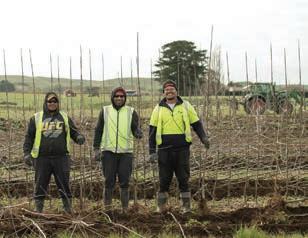
That has also resulted in HortNZ increasing its capability into areas such as labour availability and environmental policy settings, and pan-sector risk policy, while decreasing its role in others, such as with specific product market access and specific product biosecurity activities, areas where product groups have taken leadership.

Change is not without its challenges, and in this case in the process of transformation we lost some staff who decided to move to new roles outside of HortNZ after being with us for some years. Always sad when this happens, but this is often part of transformation, and I recognise and acknowledge these are people who have done terrific work in their time with us for horticulture and for growers, and we wish them all the very best in their new jobs.
But also and excitedly, we have recruited people with new skills and experience, and suited to how the organisation in today’s world needs to work to be both successful while working sustainably.
We have for some time been suggesting better ways of collaboration with product groups and district associations that is definitely needed, and which we are committed to making happen. What I saw when coming on the board was multiple organisations that were not sure of what their roles were, with everyone wanting to do everything, which ended up with lots of duplication and inefficiencies, and even at times competing with each other. Everyone I assume was seeing the need to tell their members they had done the ‘work’, so their members would continue to support, but now we need to show leadership our members expect and put the efforts collectively into finding ways that we are fully aligned and working together, without duplication.
Advocating in these times is tough, with some enormous issues like climate change and with influential people and groups arguing for exactly the opposite outcomes that we may want, so we must be able, nimble, resilient and connected, presenting as one if we are going to succeed. All organisations need to modernise and keep both fit for purpose and relevant, and that’s exactly what HortNZ has done.
I wish the new government all the very best in leading our country, especially in caring for our people and protecting what we have, while setting policies that will be business friendly and enable growth.
It’s a tough gig with all the competing issues and needs, but rest assured with horticulture we have an industry plan, and HortNZ has a new sense of purpose and energy that will see us knocking on your doors sooner rather than later to get action on the opportunities for horticulture that we know are real but that are not currently being enabled.
Kia kaha.
Here’s to a budding 2024
With the final trees having left the nursery, we’re wrapping up the season feeling more resilient and optimistic for the year ahead. A big thanks to our RSE workers, our customers and horticulture connections for your unwavering support. 2024 is set to be a fruitful year!


Thanks for your support TRACTA65870_PARTNERSHIPS_OM sales@gnl.nz 021 827 831 Enquire today to plan for future planting
The need for certainty
As you read this column, the General Election will be days away. And no matter what the polls are showing, there will still be a lot of uncertainty about the outcome. Which minor party will be kingmaker, what disruption might play out and how quickly can we get on with firstly rebuilding our sector, and in doing so the New Zealand economy?
Nadine Tunley : HortNZ chief executive

To have the confidence to make investment decisions, businesses need certainty. A lack of certainty around elections is one reason the share market and New Zealand dollar often dip around election time.
The lead-up to the election has been characterised by an avalanche of promises in the shape of new initiatives and policies. The Finance Minister has announced government department spending cuts, by between one and two percent. While that doesn’t sound like much, it still represents hundreds of millions of dollars and creates a slowdown in the public service, and for our sector potentially support in the form of government funding. Some would say the cuts are a positive thing, especially if it slows the tidal wave of regulatory change we have been enduring for the last 12 months or more, changes that are now in the throes of being implemented with
varying degrees of risk and complexity. But on the other hand, it could equally be a bad thing because of the complexity of those proposed changes. Not only that we could lose the very people who developed these complex regulatory changes, so the risk is that further unintended consequences are felt. We can only hope the next government are quick to get across everything and make the required amendments to prevent perverse outcomes.
In summary, the uncertainty – current and to come – is a bit of a Catch 22. Then there’s the traditional Kiwi Christmas closedown, which after a General Election, is always longer than ideal.
From horticulture’s perspective, implementation of the Natural and Built Environment Act (NBA) – because of the support it provides horticulture – needs to speed up.
Acting Editor:
John Gauldie
Email: editor@hortnz.co.nz
Advertising Manager:
Jackie Enright
Ph: 04 494 9986
Mobile: 0274 489 913
Email: jackie.enright@hortnz.co.nz
Design:
Scenario.co.nz
Ph: 04 385 9766
Email: joy@scenario.co.nz
Subscriptions:
Email: info@hortnz.co.nz
This publication uses vegetable based inks and environmentally responsible paper produced from Forest Stewardship Council® (FSC®) certified, Mixed Source pulp from Responsible Sources.
Paper produced using Elemental Chlorine Free (ECF) and manufactured under the strict ISO14001 Environmental Management System.
The wrapper we use is 100% recyclable, it is LDPE 4 (Low Density Polyethylene) Soft Plastic and meets the required standards. For further information refer to: https://www.recycling.kiwi.nz/our-story
THE CHIEF EXECUTIVE
Alternatively, if the incoming government wants to repeal the NBA, this needs to happen as quickly as possible, with growers being given the certainty that any new laws and regulations relating to land and water will support fruit and vegetable growing to the same – if not greater – extent than the NBA has been designed to do.
PREFU SHOWS DETERIORATING STATE OF THE BOOKS
Similarly, growers need greater certainty in the labour space. With a better season predicted, touch wood, growers will need access to a reliable and right sized pool of labour at sustainable wage rate levels. For example, paying workers from the Pacific more than their New Zealand counterparts will likely create challenges and risk for employers. This situation could result in growers deciding not to participate in the Recognised Seasonal Employer (RSE) scheme, because being part of the scheme is comparatively too expensive. This outcome would not serve either the Pacific or New Zealand in achieving the right outcome.
My request to whoever wins the General Election, especially if it’s a coalition, is this. Come together as soon as possible for the good of New Zealand and support the agricultural sector, especially horticulture, to thrive for not only the health and wellbeing of New Zealand, but the rest of the world as we supply great tasting, low carbon and healthy food.
Annual General Meeting
Saturday 11th November 2023, at 4.00 pm and Online (MS Teams), 1000 Te Matai Road, Te Puke. All commercial growers of passionfruit are invited to attend the in-person meeting or on-line meeting. Membership to the NZPGA is not required to attend, but is required to vote. Meeting details, venue and on-line meeting link will be included in the AGM Pack. For an AGM pack, please email: Christine Herbert, secretary@passionfruit.org.nz
The Pre-election Economic and Fiscal Update (PREFU) released 12 September showed a deterioration in the government’s accounts from that contained in the May 2023 Budget. It does not contain policy announcements (like the Budget) but is simply Treasury’s independent view of the books as they currently stand.
Economic activity
(Gross Domestic Product)
Mediocre growth over the forecast period to June 2027.
Inflationary pressures
Subside from 6% in 2023 to 3.8% in 2024. Dropping from 2.5% in 2025 down to 2% in 2027.
Unemployment
Picking up pace from 3.6% in 2023 to 4.8% in 2024, and peaking at 5.4% in 2025. Remaining just under the 5% threshold through 2026–2027.
The current budget deficit (before gains and losses)
$11.4 billion in 2024, then dropping to $6.2 billion in 2025 and back into a surplus of $2.1 billion by 2027.
Core Crown tax revenue
Growing from the 2023–24 year, rising from $112.4 billion in 2023 through to $147.2 billion in 2027.
Core Crown expenses
Increasing at a fair pace, and above Core Crown tax revenue, rising from $128.0 billion (32.5% of GDP) in 2023 through to $153.6 billion (31.4% of GDP) in 2027.
Net Core Crown debt
Increasing from $71.4 billion in 2023 to $91.9 billion in 2024, and to over $100 billion in 2025 and 2026. Only in 2027 is net Core Crown debt forecast to decrease slightly.
We can only hope the next government are quick to get across everything and make the required amendments to prevent perverse outcomes
The ORCHARDIST : OCTOBER 2023 5 THE CHIEF EXECUTIVE
YOUR LEVY AT WORK
INDUSTRY WIDE ISSUES FOR INDUSTRY GOOD
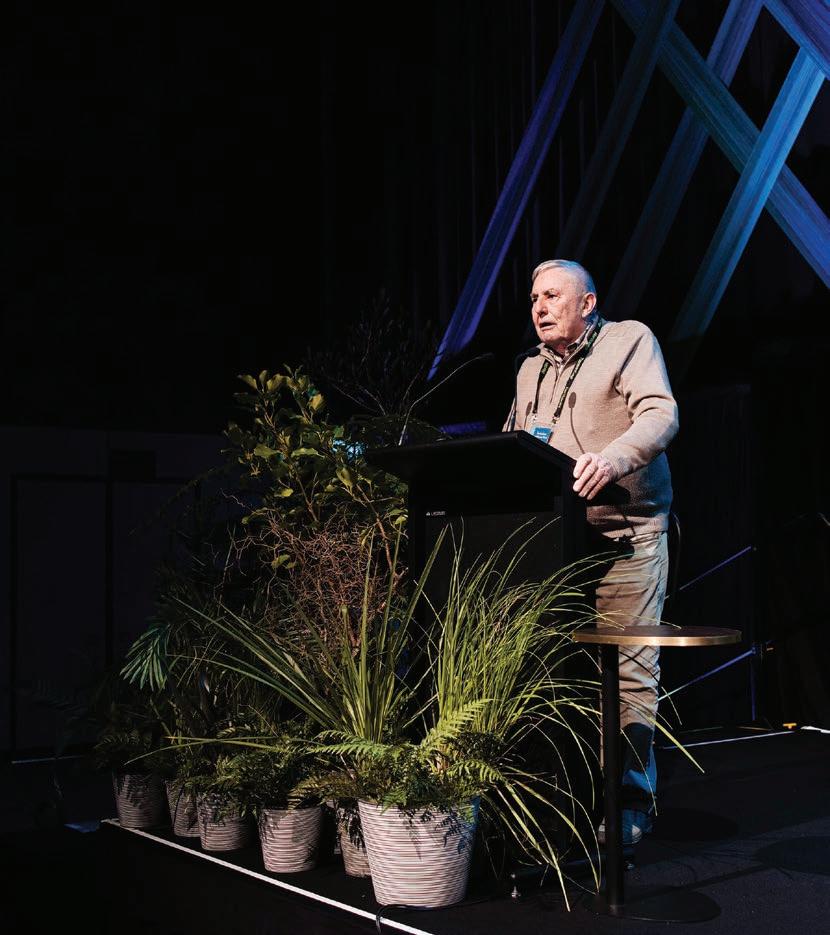
An outstanding contribution to horticulture Page 10
Associate director role was a chance to give back
Horticulture New Zealand’s 2022 associate director, Emma Lees, names the biggest benefit she gained from taking on the role as getting a more holistic view of the industry.
 Glenys Christian
Glenys Christian
“There was so much to the role,” she says. “It was very varied and there was a lot of opportunity to speak to all types of people in the industry and engage with them. I met with growers from all around the country.”
One experience that sticks in her mind is the three days she spent in the South Island meeting with summerfruit growers.
“I knew nothing about cherries, nectarines, apricots etc.,” she says. “The opportunity to see and understand some of the challenges and opportunities in these crops was eye-opening.”
Emma says that also seeing first-hand the HortNZ and industry response to Cyclone Gabrielle was a huge learning. “Some of the board directors were personally affected by the cyclone. Hearing their stories and being part of the board and HortNZ response, including advocating to the government on the industry’s behalf was a huge personal learning.”
AS Wilcox managing director, Kevin Wilcox, first drew the associate director role to her attention, suggesting it would be good opportunity to continue her personal development.
The ORCHARDIST : OCTOBER 2023 7 YOUR LEVY AT WORK
Emma Lees – impressed with horticulture’s focused youngsters with an innovative mindset
“It was a good way to give back, fitted with my future career development as well as being a good chance for personal growth,” she says.
“There was a really good induction process and I was made to feel welcome from day one.”
Not only did board members encourage her questioning, they also provided clarification where it was required.
“It’s a really well-structured board working across a complex industry,” she says.
It’s not just reading board papers and attending the board meetings
She had been at AS Wilcox for 18 months when the opportunity arose, having spent the previous 15 years in strategic human resources leadership roles in the United Kingdom and New Zealand, focusing on governance, organisational performance and culture. The organisations she has worked for include Airwork Holdings in New Zealand, Cambridge University’s School of Biological Sciences in the United Kingdom and Syngenta in Europe.
Another highlight of her year in the associate director role was attending and meeting finalists in the Young Grower of the Year competition.
“It was exciting to see really focused young leaders with innovative mindsets,” she says.
An aspect of horticulture she was able to develop a deeper understanding of was the Recognised Seasonal Employer (RSE) scheme.
“I didn’t have an in-depth knowledge about how the political landscape keeps moving in this area.”
Emma realised soon after taking up the role in late February last year she had underestimated the time commitment being an associate director involved.
“It’s not just reading board papers and attending the board meetings” she says.
“There is also engagement with growers, attendance at other events as a board representative and then reviewing learnings personally. However, the associate director role gave me so much. I am very grateful to have been awarded the opportunity.”
Now she’s keen to start looking at what governance opportunities she will next seek out. While she would like that to be in horticulture, she will also look to a role in the charitable sector over the next year.
And because of her HortNZ experience – “I’ll be really confident going into that.”
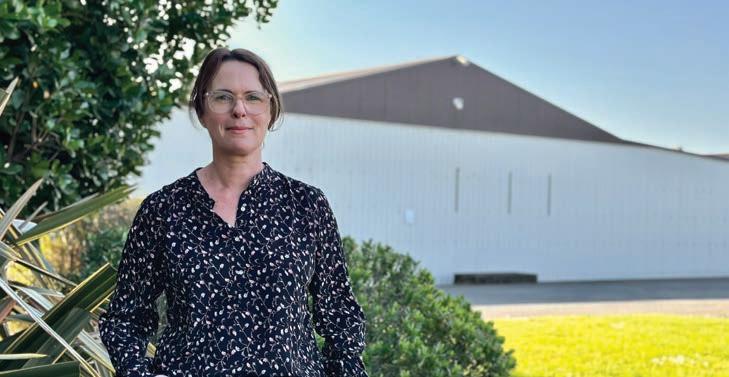
8 The ORCHARDIST : OCTOBER 2023 YOUR LEVY AT WORK
It was a good way to give back ... as well as being a good chance for personal growth
GROW WITH AG-STEEL

For all your Kiwifruit development needs
• Ag-Beam
• Ag-Stringing Pole
• Ag-Net Pole
• Ag-Brace
• Ag-Tripost
• Ag-Support Post
LOGAN WHENUAROA IS THE 2023 ASSOCIATE DIRECTOR AT HORTNZ
The associate director initiative is a development opportunity for a future leader to join the Horticulture New Zealand Board in a non-voting role and gain experience in governance, leadership and strategy. This year the board has appointed Logan Whenuaroa, avocado manager at Apata Group. His experience includes roles as executive committee member and chair of the New Zealand Avocado Packer Forum; NZ avocado, quality standards and export marketing strategy (EMS) review committees; and advising independent orchards on nutritional inputs, pruning, irrigation and agrichemical use. He has a Bachelor of Agricultural Science from Massey University.

|
ORDER ONLINE
agsteel.co.nz
The ORCHARDIST : OCTOBER 2023 9 YOUR LEVY AT WORK
Max Lilley – horticultural industry visionary
At this year’s Horticulture Conference, grower Max Lilley took home the Bledisloe Cup, awarded annually in recognition of individuals who have made an outstanding and meritorious contribution to horticulture. He shared some of his career milestones with ELAINE FISHER.

Fifty years ago vegetable grower Max Lilley was among the first New Zealanders to try a strange new green vegetable, and he wasn’t impressed.
“Our friend Murray Stephens invited Margaret and I to dinner. We were invited to try this unusual vegetable no one had ever seen before, which Lincoln University was trialling. There was a great discussion about it. Margaret liked it. I wasn’t keen on it. Little did we know how huge the broccoli market would become,” says Max, who was awarded the horticulture Bledisloe Cup at the Horticulture Conference 2023. Max went on to be a major grower of broccoli, now among New Zealanders’ favourite vegetables. While the
strange vegetable may not have initially appealed to Max, his instinct for other future directions of the industry were never wrong.
Max’s earliest memories of vegetable growing are of hoeing mangel beets for pocket money when he was about eight years old.
“It was a terrible job, but if you didn’t hoe mangels you didn’t get pocket money.”
His father Ray and uncle Colin were mixed cropping farmers at Southbridge. “It was just after the War, and no one had much money. I remember Mum and Dad with the ration book deciding what they could buy with coupons. It was an era of toughness. You had to be careful with money. We never had much, as the whole war
FEATURE ARTICLE 10 The ORCHARDIST : OCTOBER 2023 YOUR LEVY AT WORK
Max Lilley receiving the Bledisloe Cup at the Horticulture Conference this year with Bernadine Guilleux, HortNZ board director (left), and Barry O’Neil, HortNZ chair (right). Photo by Smoke Photography
1
was common, but it is a practice which has been discontinued

effort took the sting out of the country. But that was how it was. You grew up with the times.”
Some would say things got tougher for Max when he left home to become a border at Timaru Boys’ High School. “In the fourth form I was in the open-air dorms of Thomas House. There were no windows. The worst thing was that fourth formers had to clean the dorm and in the autumn the leaves kept blowing in. I never missed the windows at all. The dorm is all covered in now.”
When he left school, Max took a job as a fitter welder, skills which came in handy when he operated his own machinery. Later he worked with his father and brother on the Southbridge farm.
Little did we know how huge the broccoli market would become
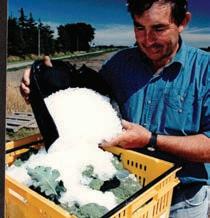
In 1958 the family farm introduced irrigation. “It was a towline on skids with five-inch pipes, big heavy beasts to move around.” In the early 1960s the Lilley family began growing peas, beans, cauliflower and Brussels sprouts for food processor Wattie’s.

“Later we grew mechanical harvest tomatoes for a pickle factory. The definition of a mechanical harvest tomato was one you could drop from a metre, and it maintains its shape and doesn’t break. They were beautiful tomatoes. I don’t think you can get them anymore.
NZ Feijoa Growers Association’s AGM & Field Day
The 2023 AGM & Field Day is being held in Gisborne on Friday 3rd and Saturday 4th November 2023.
The AGM is being held on the evening of the 3rd, with the field day on Saturday. Our Conference dinner will be held on Saturday night.
If you would like further information, please email info@feijoa.org.nz or visit the Association’s website www.feijoa.org.nz. The programme and registration are available from our website.
We look forward to seeing you there!
www.feijoa.org.nz

 Brussels sprouts being harvested on the Lilley farm 2 Max and Margaret Lilley (right) lunching with a Japanese Agricultural Exchange executive during a visit to Japan, at which the Lilleys were representing New Zealand growers 3 Max and Margaret Lilley (right) pictured during a visit to Japan with (centre) Akira Tanino,chairman of the Japanese Vegetable Supply Stabilisation Fund which was influential in the importation of vegetables, mainly onion and squash. To the right are flower growers from Hungary, and in the back row members of the Japanese Ministry of Agriculture and Japanese Vegetable Supply Stabilisation Fund 4 When Max Lilley first began growing broccoli, ‘icing’ to keep it fresh for transport
Brussels sprouts being harvested on the Lilley farm 2 Max and Margaret Lilley (right) lunching with a Japanese Agricultural Exchange executive during a visit to Japan, at which the Lilleys were representing New Zealand growers 3 Max and Margaret Lilley (right) pictured during a visit to Japan with (centre) Akira Tanino,chairman of the Japanese Vegetable Supply Stabilisation Fund which was influential in the importation of vegetables, mainly onion and squash. To the right are flower growers from Hungary, and in the back row members of the Japanese Ministry of Agriculture and Japanese Vegetable Supply Stabilisation Fund 4 When Max Lilley first began growing broccoli, ‘icing’ to keep it fresh for transport
1 2 3 4 The ORCHARDIST : OCTOBER 2023 11 YOUR LEVY AT WORK
“Harvesting them was backbreaking work. I got my ears pinned back severely by the buyer because I had not sprayed them when I should.
“From then on, my mantra has been “Tight Management”. The tough stuff about vegetable growing is that if you want to do it properly, you have got to do everything at the right time.”
When Wattie’s bypassed a 23-acre crop of cauliflower for processing, the Lilley family got into direct marketing. “They paid us for the crop and said we could sell it if we wanted. We carted cauli all over Canterbury direct selling to supermarkets and were rather pleased with the results. We also grew broccoli for ourselves alongside Wattie’s crop.
“As well as broccoli we were growing Brussels sprouts, for which we imported a harvester, and when Wattie’s decided to withdraw from that crop, we continued growing broccoli, developing and selling that crop for the fresh market.”
The family was approached by a Progressive representative to grow broccoli directly for the supermarket. “We knew the rest of the growers would not take too well to that idea, but Progressive guaranteed to support us, and after a couple of years the market got used to the idea.”
In 1990 when his father Ray passed away, the family farm was sold, and Max and Margaret decided to go out on their own.
“We wanted somewhere closer to the markets and with the right soils. We chucked a spade in the boot and drove north, looking at every lifestyle block for sale.”
“FOR THE GOOD OF THE WHOLE INDUSTRY” –HOW HORTICULTURE NEW ZEALAND WAS FORMED
In awarding Max Lilley the Bledisloe Cup, HortNZ board chair Barry O’Neil described him as “one of the visionaries behind the formation of Horticulture New Zealand”.
It was while chairing a Trans-Tasman Horticultural Conference in Sydney that Max saw first-hand the strength of the New Zealand Fruitgrowers’ Federation’s relationship with government.
“Back then Australia would not allow the import of New Zealand apples. Among the reasons was the claim the disease fire blight was not present in Australia. During the conference a couple of guys, who shall remain nameless, took a trip around Sydney and found fire blight. “They came back to tell me, saying they were going to ring the Agriculture Minister and tell him ‘and there will be hell to pay’. What impressed me was as soon as one of New Zealand’s largest product groups got involved with government, they listened and the
pressure of Fruitfed (New Zealand Fruitgrowers’ Federation) and the apple industry together loosened up the ability to export apples.
“That sort of stuff made me realise we needed to amalgamate, because fruit growers had more power than vegetable growers and got ministers to listen to them.”
At the time Max was president of Vegfed (NZ Vegetable and Potato Growers Federation). “Vegfed was so small that we never got much recognition at a political level. We had to plead with government to take note of us when drafting legislation.”
Vegfed did have a close working relationship with the NZ Fruitgrowers’ Federation, including sharing chief executive Peter Silcock. “I discussed my idea for amalgamation with Peter then went to the Marlborough Sounds, meeting Fruitgrowers’ Federation president Martin Clements. Sitting on the beach enjoying a couple of beers we worked out a plan.
“He went back to his board, and I went to mine to put the proposal, which was accepted. Then I buggered off (from the president’s role) and left them to it.”
Max is proud of Horticulture New Zealand, which was formed in a merger of the New Zealand Fruitgrowers’ Federation, the New Zealand Vegetable and Potato Growers Federation, and New Zealand Berryfruit Growers’ Federation in December 2005.
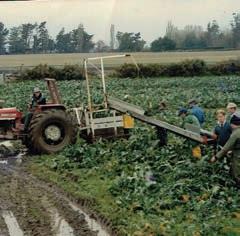
“HortNZ does a hell of a good job for our industry. I was impressed to see members of parliament, ministers and the diplomatic core at the Horticulture Conference in August.”
Individual grower sector groups did not lose their autonomy in the merger. “All the sectors can do their own thing, but come together through HortNZ for the good of the whole industry.”
12 The ORCHARDIST : OCTOBER 2023 YOUR LEVY AT WORK
The soil Margaret and Max wanted was Templeton Silt Loam and they found it on a former apple orchard near Rolleston. “We put the spade down and found beautiful soil, wow 2.3 meters down to the first stone.”
Leasing additional land, the couple returned to growing broccoli and later downsized to grow pak choy and Shanghai pak choy on their 3.8-hectare block. “It was quite comfortable financially, but by 2014 I was getting sick of crawling round the paddock picking greens. I told my neighbour Allen Lim I was going to tell the supermarket I’d had enough.
“Over a cup of coffee, we decided to bring our two businesses together. I said you are the boss and I’m unreliable. Today it’s Jade Garden Produce, with a wonderful staff who play an active part in it. I don’t play much of a role, though my business card says I’m a technical advisor – I’m more of a mentor I think.”
In 2019, Margaret Lilley died in a mountain biking accident. “Life around here is pretty quiet now,” says Max who, as well as maintaining the home garden, still pursues the sports of skiing and mountain biking he and Margaret loved to share. “She was a remarkable woman, and I could not have done all I have without her help and support,” says Max.
...my mantra has been “Tight Management”
Alongside his career as a vegetable grower, Max was chairman of the Canterbury Growers Society Process section, playing a key role in successful price negotiations with processors, which brought growers a 15 percent increase in returns for some crops.
For 17 years Max served on the processor sector of the Vegfed (NZ Vegetable and Potato Growers Federation) council, becoming Vegfed president in 1990. During his time on the council Max served on the rural safety, the cultivars advisory and the quarantine committees. He was a director of Vegetable Producers Publishing Company and Vegfed’s environmental spokesperson during the development of the Resource Management Act.
When Max was Vegfed president, the Commodity Levies Act was introduced, and he led the organisation through a successful process and outcome. Max also worked on closer relationships with Federated Farmers.
Today, Max chairs the Growers’ Trading Company Trust, created when the company was sold to Farmlands. The proceeds of the sale were used to set up a trust for the advancement of horticulture in Canterbury. He also continues to be an active member of the Canterbury Growers’ Association.
Transtak Bin Trailers
Transtak® 3500N/NS: 6 bin carrier
• Tractor front/rear mounted to load/carry/stack 3-6 full bins & 9-12 empty bins.
• 3000kg load capacity/1.0 metre lift with forks tilt & Transtak Soft-Ride suspension.
• T3500NS model with forks side-shift to stack wooden & plastic bins.
Transtak® 3000LT: 6 bin trailer

• 3000kg capacity/6 bin capacity bin trailer with LED tail lights & hydraulic lock-out for on/off road use.
• Max 500mm lift height with forks tilt to load anywhere.

• Transtak Soft-Ride suspension for kiwifruit, apples, stonefruit etc.
Transtak® 1500LP
• 3 x Bin or 1500kg Capacity, Front or rear mount
• Designed with low tandem wheelsets for access to 3.5m rows in modern planting environments
• Transtak Soft-Ride Suspension System

Transtak® 1500H
• 3 x bin or 1500kg Capacity, front or rear mount
• Will lift and stack to 1.0m, to allow stacking of full bins for transport.
• Transport and de-stack lots of 9-12 empties for efficiency in the orchard environment
• 2 x double acting hydraulic rams for lift and tilt


Transtak® 1500L/LE 3-4 bin trailers
• Transtak 1500L 3 bins: apples, kiwifruit, avocados, stonefruit etc.
• Transtak 1500LE – 3-4 bins/1900kg capacity with plug-in extension forks.
• Transtak Soft-Ride suspension fitted.
Transtak® 750ATV bin trailer (Demo video on the website)
• Efficient ATV: 800-900kg 2-bin handling trailer.



• Electro-hydraulic lift & lower.
• Transtak Soft-Ride suspension fitted.
Transtak® 1200BF 3 ptl stacking binfork; 2 bin capacity
• Bin stacking in orchard rows 1200kg capacity.
• Soft – Ride hydraulic accumulator fitted.
The TRANSTAK® range of Bin Trailers offer the fruitgrower outstanding bin handling efficiencies.
30 Hau Road Motueka. Freephone 0800 30 30 63; sales@transtak.co.nz
www.transtak.co.nz The ORCHARDIST : OCTOBER 2023 13 YOUR LEVY AT WORK
Cherry challenges

Page 28
YOUR INDUSTRY
ACROSS THE SECTOR — ACROSS THE COUNTRY
Still wait-and-see to determine post-Cyclone tree deaths

It is still early days, but so far, post-cyclone citrus tree deaths in Gisborne are mostly limited to orchards hit by thundering volumes of woody debris. KRISTINE WALSH reports.
Murry Cave must be credited with having provided the quote of the cyclone season.
Back in June, Gisborne District Council’s principal scientist described the soil around the sodden region as “like porridge,” then just a few days later – after a week of even more rain – said further deterioration meant it had the texture of “melted ice cream”.
It was an evocative image of land that could no longer hold itself onto hillsides, let alone provide a nurturing environment for plants to grow.
Now the consequences of that are starting to emerge, and while it’s not great, tree deaths are not as widespread in the region as initially feared. Yet.
Scientists say it could be months – even a couple of years – before the impact of continual rain and flooding will truly be seen on tree health in a region rich with apple, kiwifruit and especially citrus orchards. But if anyone knows where those impacts might be seen it is Murry, who in his seven years with Gisborne District Council has been involved in everything from hazard assessment to flood mapping.

FEATURE ARTICLE COVER STORY The ORCHARDIST : OCTOBER 2023 15 YOUR INDUSTRY
Gisborne District Council principal scientist Murry Cave says post-cyclones, there is no time to be a specialist: “You end up being a jack-of-all-trades”
His feet have barely hit the ground since Gisborne was hit first by Cyclone Hale (in January) and then the mega-crunch from Cyclone Gabrielle in February.
Much of that work has centred on the more than 40,000 landslides recorded by August in the district – in both city and rural areas – movement caused, in another ‘Murryism,” by soil “that is just slop”.
But he has still devoted a lot of energy into recording other images and data that will later be extrapolated for analysis.
In the meantime, he has drone images that clearly show where early tree deaths were occurring, and he says, they were not unexpected.
It is now estimated that Cyclone Gabrielle mobilised up to two million cubic metres of woody debris and those orchards got absolutely hammered
Two citrus orchards in particular have been affected and both are near rivers – one at Manutuke, heading south of Gisborne, the other on the East Coast in an area that has for five years taken hits from water events exacerbated by the movement of woody debris.

In fact, says Murry, that debris is likely to blame for the early impact on trees.
“As time goes on we will be able to use the infrared capability of the drones to record the impact on vegetation, but in the case of the early-affected orchards, the dieback is abundantly clear,” he says.
“In both of those cases a large amount of woody debris went thundering through and it was that physical impact, rather than just water, that ripped up the ground and munted the trees. It is now estimated that Cyclone Gabrielle mobilised up to two million cubic metres of woody debris and those orchards got absolutely hammered.”
His concern now, Murry explains, is the land and debris disrupted by those big storms that did not make it into the waterways.
That means everyone – growers included – needs to be aware of what is happening on the hills above and near them.
“Because that land might be unstable or that debris might have been mobilised, there is the potential for a residual effect where even a smaller storm could set it on the move. So there is absolutely, the potential for this to happen again.”
As for those trees that got wet, if not munted, Murry believes trees affected by standing water or silt are more likely to survive.
Murry Cave says an analysis of woody debris that smashed through Tam and Dan Jex-Blake’s orchard shows that 70 percent of it was pine
16 The ORCHARDIST : OCTOBER 2023 YOUR INDUSTRY
70% of the woody debris was pine
“But that is still a bit of an unknown, so we are tracking progress by taking a whole lot of soil samples. Six months down the track we’ve already identified some atypical chemical signatures like an increase in acidity, so that’s another issue that could impact on plant health,” he says.
“We haven’t even finished cleaning up after Cyclone Hale, let alone Gabrielle, and we are not expecting to see the soil drying until summer, so this is just an ongoing thing we are going to have to work with all winter.
“The key things are to follow advice in rehabilitating and caring for trees in inundated areas, and in terms of land movement, keep a sharp eye out for things like doors not closing properly or unusual noises around the house … any signs of instability in the dwelling.”
In terms of caring for those orchards, there is good news in the August-to-October forecast from the National Institute of Water and Atmospheric Research (NIWA), which predicts that the Gisborne, Hawke’s Bay and Wairarapa regions are most likely to experience above average temperatures and more frequent warm westerly winds, great indicators for drying weather.

NIWA also predicts a 40 percent chance of below-normal rainfall and river flows; stronger than normal seasonal wind speeds; and a lower likelihood of tropical moisture plumes. However, occasional easterly winds may still bring heavy rain from time to time.

Overseas experience shows that in the case of flooding, standing water and silt inundation, the long-term impact will depend on both the soil and the trees.

If the oxygen that occupies tiny spaces in the soil is replaced by water for any length of time, plants cannot breathe and can literally drown. University of Florida

master gardener Paula Weathersby says roots standing in water for more than three days could be affected, a particular irony being that, as time goes on, damaged roots may not be able to take up sufficient water.
In addition, an absence of oxygen creates a great environment for bacteria and fungi that can also kill a tree.
The key, Paula says, is to pay attention as a tree that may look like it is recovering could still have a shallow or damaged root system that could be especially vulnerable to insects and disease, and will be susceptible to drought when dry conditions return.
The ORCHARDIST : OCTOBER 2023 17 YOUR INDUSTRY
LESSONS FROM NEW SOUTH WALES
In terms of citrus in particular, there have been many lessons learned in the Australian growing region of New South Wales – which has had more than its share of flood events – with infection by the root rot fungus Phytophthora citrophthora identified as a main cause of tree death. Faulty irrigation practices, lack of adequate drainage and uneven soil types were shown to have aggravated tree losses.

However, it was shown that trees on trifoliata rootstock – commonly used in New Zealand orchards – coped better in waterlogged conditions.
After early actions like removing silt, digging drainage trenches and avoiding soil compaction, advice from the New South Wales Department of Primary Industries includes:
Check branches of young trees for build-up of soil or insects, or the presence of collar rot
Check the trunks of older trees for signs of collar rot and perhaps apply a protective copper spray
Skirt low-hanging branches
Be alert to root damage and reduce irrigation and fertiliser amounts accordingly.
‘IT’S THE WOOD WE CAN’T HANDLE’
The renowned Te Arai River wanders past Tam and Dan Jex-Blake’s orchard at Manutuke, just south of Gisborne, and across the bottom of the valley at their home on the sheep and beef station 30 kilometres up the road.
“We know the river and we can cope with water … it’s the forestry slash we can’t handle,” Tam says of the damage sustained in the wake of Cyclone Gabrielle. The orchard had been hit before, but this time it was worse. Woody debris – mostly slash – smashed through ten rows of the eight-hectare navel orange block, and with its trajectory compromised, the river swept through the navels, other citrus and five hectares of Rockit apples in an adjacent block.
Six months later a monstrous, tangled pile of wood –some entire trees – still punctuated the formerly neat lines of navel orange trees.
“By removing silt from the base of every tree we managed to save the Rockits, but I didn’t even go into the navel block for two months after the cyclone,” says Tam.
“My daughters gave me a condition report and it was clear there was nothing we could do. It stayed wet for months and we couldn’t get machinery in there to even start working on that giant pile of wood.”
Initial damage to trees in parts of the navel block was caused by the physical impact of woody debris. But now months of standing water and silt cover is affecting those out of the line of fire, to the point where six out of the eight hectares of navels is showing the strain.
And while Tam does hope to get a light harvest this season, those trees too, will get the post-flood treatment of silt-clearing and pruning in the hope of saving them.
“Citrus is amazingly resilient and can handle a bit of flooding, but the impact of this slash is different,” she says.
“It been the same at the station as it is here at the orchard. Up there, and as a direct result of the slash, we lost two critical farm bridges and it will cost hundreds of thousands to reinstate all-weather access to parts of our property.
“The business interruption has been significant and as we say, it’s not the water that’s the problem … it’s the wood.”
18 The ORCHARDIST : OCTOBER 2023 YOUR INDUSTRY
A new level of confidence in DMIs
Belanty fungicide gives New Zealand growers complete confidence in the control of black spot and powdery mildew in apples, black spot in pears and powdery mildew in grapes. Setting a new global standard for DMI’s, Belanty is able to control pathogen strains that old DMI’s are struggling to control. Belanty is the breakthrough you’ve been waiting for.
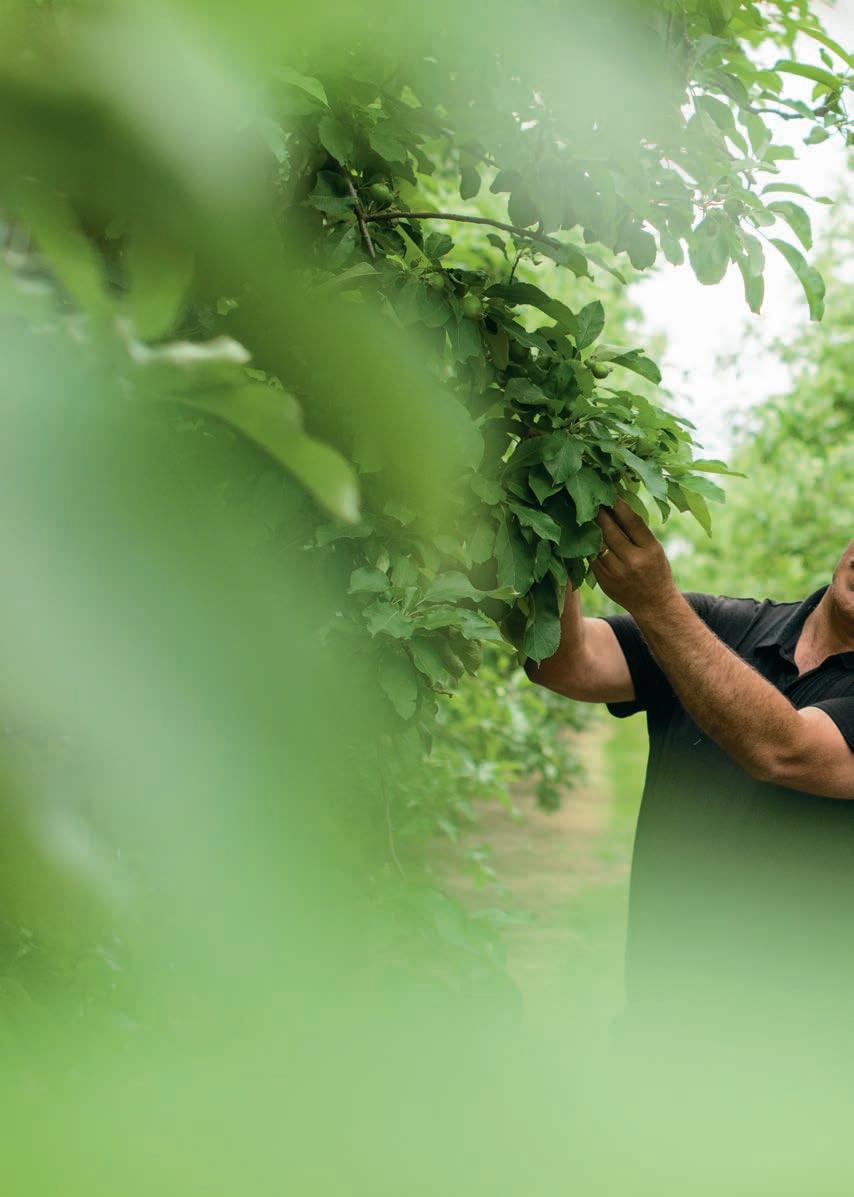

CONFIDENCE GROWS HERE
ALWAYS READ AND FOLLOW LABEL DIRECTIONS. Belanty Fungicide ACVM registration number: P009798. © Copyright BASF 2023 ® Registered trademark of BASF. 213827 0823
crop-solutions.basf.co.nz
Talk to your local reseller or visit
New apples take the next big step
Two new apple varieties have reached significant milestones as the first PoshTM fruit is launched in China and the first commercial plantings of JoliTM go in the ground.

The first container of Next Generation Apples’ variety, Posh, arrived in China’s city of Guangzhou in early September. Around the same time, T&G Global began commercial plantings of its newest global premium apple variety, Joli, on one of its Hawke’s Bay orchards. Posh has been bred from Honeycrisp and Sciros by Plant & Food Research and commercialised by Prevar. Next Generation Apples which is a joint venture between Golden Bay Fruit in Tasman and Taylor Corporation in
Anne Hardie
Hawke’s Bay, is the licence holder for growing and marketing the variety.
The result is a very large, round and bright-red apple with tiny lenticels. Inside, the texture is more refined and delicate than a standard apple.
Chief executive Evan Heywood says Posh has the delicate texture and taste profile of Honeycrisp but is far easier to grow. He says the yield per tree is also high due to the large fruit size and good colouration.
20 The ORCHARDIST : OCTOBER 2023 YOUR INDUSTRY
From left: Eleni Hogg, marketing lead Next Generation Apples, Evan Heywood, chief executive Next Generation Apples, Kelvin Taylor, owner Taylor Corporation
Ethnographic research in target markets, Vietnam and China, confirmed consumers love the look of the variety and noted it was a perfect apple for gifting due to its large size and bright-red hue.
Prevar chief executive Tony Martin says the distinctive texture and high quality of Posh gives it a unique place in the wider portfolio of premium apples from New Zealand.

So far, Next Generation Apples has planted 50ha among its own growers and is seeking expressions of interest from independent growers to be part of the commercial growing pilot.
As well as sending a container of Posh to Guangzhou, small commercial volumes of the variety are available from Taylor Corporation and Golden Bay Fruit.
For all temporary water chillers or a customised solution to suit your needs call us today.
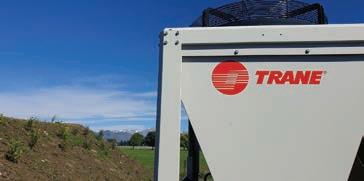
Gary Morris
Phone: 0272 836 949
Email: gary.morris@tranetechnologies.com


... consumers love the look of the variety and noted it was a perfect apple for gifting due to its large size and bright-red hue
What you need, when you need, for how long you need, with full service support and set up. The perfect solution for the season. Cool It! Hire or buy your chilled water cooling equipment
Next Generation Apples has planted 50ha of Posh apples
The ORCHARDIST : OCTOBER 2023 21 YOUR INDUSTRY
www.trane.co.nz
Meanwhile the initial planting of Joli is part of the planned 27ha T&G intends to plant on its Hawke’s Bay orchards during the next three years. A further 170ha will be grown under licence by independent growers across New Zealand.

T&G Global’s chief executive, Gareth Edgecombe, says the first commercial planting is the result of a decade of innovation to produce the variety which is a productive, large, fullflavoured, bright-red juicy apple. He says it will appeal to both consumers and growers.
Throughout its development phase, Joli has been trialled across New Zealand to ensure the trees grow consistently in different environments and cope with various climatic conditions. He says the variety produces great tasting fruit that stores well.
“We know the trees have very strong orcharding attributes, including high yield and the ability to grow throughout New Zealand. As we begin to commercialise Joli we’ll closely monitor and evaluate our orchards to further inform and assist our growers as planting continues to expand in coming seasons.”
Joli is the result of T&G’s IP (intellectual property) management and commercialisation business, VentureFruit, working closely with Prevar and Plant & Food Research.
Since its launch, expressions of interest from growers have been sought and Gareth says a number of growers are now confirmed to receive allocations of Joli tree stock for planting in 2024. Apples will be available for consumers to purchase from 2028 onwards. The next round of expressions of interest for Joli plantings in New Zealand open midyear in 2024, while tree stock will become available for international growers in the next five to six years.
We know the trees have very strong orcharding attributes, including high yield and the ability to grow throughout New Zealand
T&G intends to plant 27ha
of Joli apples during the next three years
22 The ORCHARDIST : OCTOBER 2023 YOUR INDUSTRY
T&G has begun planting 27ha of Joli in Hawke’s Bay and a further 170ha will be grown across the country


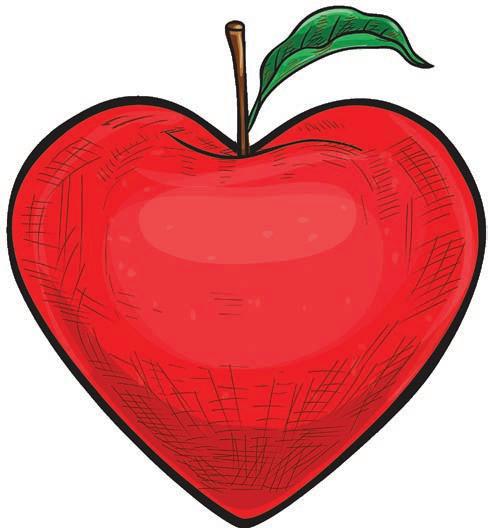


The new chemistry apple growers will love Property® from UPL Talk to your local merchant to find out more. The new fungicide on orchard blocks, Property, delivers outstanding control at all infection stages of powdery mildew. Registered pursuant to the ACVM Act 1997, No. P009953 See www.foodsafety.govt.nz for registration conditions. Approved pursuant to the HSNO Act 1996. Approval Code HSR101410 See www.epa.govt.nz for approval controls. Property is a registered trademark. UPL- LTD.COM
INDUSTRY
Pacific talent shines at friendly match
A hard-fought, thrilling debut rugby match between Bay of Plenty kiwifruit workers has inspired future friendly sporting duels.
Carly Gibbs
Photos by Drop Photography
A rugby game between Recognised Seasonal Employer (RSE) scheme workers who are employed by kiwifruit packhouses EastPack and Seeka, was organised by Pacific Island Rugby and resulted in a nail-biting finish.

Seeka led 6-5 before EastPack scored two back-to-back tries – the last being just before the final whistle – and converted, giving them a 17-6 victory at Blake Park in Mount Maunganui on 19 August.
Pacific Island Rugby’s Ati Aaifou-Olive, who is also Bay of Plenty Rugby’s strategic projects general manager, says the match was “brilliant”, even if he couldn’t sleep for seven nights leading up to it because he was nervous the essential workers might hurt themselves, risking their ability to work.
However, apart from a gash over the eye from a boot, a black eye, and a sore shoulder, he was relieved there were no significant injuries in the stoush.
There were more RSE scheme workers keen to play in the match than there were positions available. And despite only three weeks to prepare, it was a match that stood out for the spirit and pace at which it was played.
“It looked like they’d been playing all year,” Ati says.
“The game was structured, clean, fast, and skillful. I was like ‘What? Where did these guys come from?’ Just raw talent.”
Regional Public Service Commissioner Ezra Schuster also attended and described the experience as “a lovely festival Barbarian-style match”.
24 The ORCHARDIST : OCTOBER 2023
RSE workers employed by EastPack and Seeka took part in the rugby match
YOUR
Added to the pomp was a Pacifica ceremony prior to kickoff, in the University of Waikato Adams Centre for High Performance, situated across the road from Blake Park.
Jerseys supplied by EastPack and Seeka (who also coached their teams and supplied boots and mouthguards), were blessed by local Samoan and Fijian pastors, and both teams sang hymns.


“It was beautiful. That ceremony kicked off the day and set the scene,” Ati says.
Sideline supporters included Zespri staff, kiwifruit growers, and the wider Polynesian community. And there was food and music.
Packhouses DMS and Trevelyan’s have expressed interest in joining next year, and planning is underway to consider ‘non-contact’ sporting competitions too, and room for female RSE workers to participate.
Up to 4000 RSE workers come to the Bay of Plenty region each year, mainly from March to October, and together they
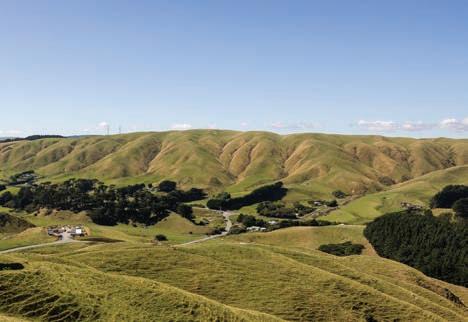
STAFF ACCOMMODATION FOR THE SEASON


From Cape Reinga to Bluff, we deliver modules to site ready to go when you need them, and remove them when the season is over. We provide flexibility for you and a welcoming, homely space for your team.
So, if you are a Recognised Seasonal Employer seeking a reliable option, contact Portacom today on 0800 476 782 or visit portacom.co.nz/rse and mention The Orchardist.
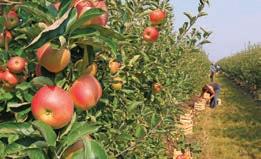 Pacific Island Rugby organised the match, which revealed a remarkably high level of talent, spirit and pace
Pacific Island Rugby organised the match, which revealed a remarkably high level of talent, spirit and pace
With Portacom, you can scale your seasonal workers’ accommodation up or down to suit your needs.
The ORCHARDIST : OCTOBER 2023 25 YOUR INDUSTRY
represent nine countries: Fiji, Kiribati, Nauru, Papua New Guinea, Samoa, Solomon Islands, Tonga, Tuvalu and Vanuatu. Ati says the rugby game has inspired conversations about how the industry could use sports to foster RSE workers’ wellbeing.

It’s about connecting communities and having a sports element to their life in New Zealand
“They are here to work, but we could play games at night. There might be a volleyball comp at 6pm; touch rugby under lights,” he says.
“It’s about connecting communities and having a sports element to their life in New Zealand.”
Ezra agrees and applauds Pacific Island Rugby for their initiative.
“There’s a whole lot of different things that come out of sport. Including getting these guys to talk about how they’re doing, because that’s mental health, right? I think the potential for other sectors to look at this as a model for engagement (for their own staff) is fantastic.”
Kura Poulava, general manager of human resources at EastPack in Te Puke, says their win was a bonus, and the blessings of the jerseys an “awesome touch” to a great day.
“It was a good vibe. Everyone was cheering each other on. Afterwards, everyone hugged, congratulating each other from both teams. The feedback has been extraordinary.”
Kura agrees that it’s essential that RSE workers’ mental and physical health is supported while they are in New Zealand. This may include things like a traditional pōwhiri when they arrive from local iwi; helping them attend church sermons; supporting their country’s Independence Day celebrations; trips out of town when it’s raining; and now, sports.
“There’s a whole lot of stuff that we’ve tried this year that we want to build on,” she says, adding that a rugby trophy for next year’s game could be on the cards.
Seeka’s people and capability manager Shelley Aitken says the match gave RSE workers “focus and friendly rivalry”, with around 100 souvenir team hoodies sold. RSE workers were keen to take one home even if they hadn’t played, she says.
Of the match, she joked that Seeka felt like “underdogs” going in as they hadn’t played for a while, but the team did well “to hold it to a fairly respectable score” in a “serious” match.
While the goal now is to grow the RSE event, they would also like to consider something wider for their seasonal staff during the main packing season.
“Everyone got in behind it, and it was great fun.”
26 The ORCHARDIST : OCTOBER 2023 YOUR INDUSTRY
The match has inspired bigger, better and more sporting events for 2024. Photo courtesy of Seeka / EastPack
Introduction to Managing Risk in Horticulture workshop


Frontline managers and growing operation owners register now for this health and safety workshop
Learn how to proactively identify and control risks. This workshop will focus on managing risks following severe weather events and related hazards.
Workshop outcomes:
Understand the legal requirements for risk assessment
Define the key terms including hazard, harm, risk (including critical risks) and controls
Developed in response to research undertaken by the Grow Home Safe project, we have partnered with health and safety specialists at +IMPAC to provide horticultural training sessions to help reduce harm in the sector.
This workshop helps growers meet their legal duties under the Health and Safety at Work Act 2015, meet GAP requirements and provide useful tools and knowledge that can be utilised to create safe systems of work for their teams.
Apply three specific tools to identify hazards
Get help with meeting GAP health and safety requirements
Explain the steps within the risk assessment process
Understand what a safe system of work is, and its importance.
Workshops are being held in weather affected regions in the North Island.
To find out more about this workshop including locations, dates and times go to www.growhomesafe.co.nz.
To register email info@growhomesafe.co.nz
Through the support of the Ministry for Primary Industries (MPI) and its North Island Weather Events fund, tickets are at a subsidised cost of $75+GST per person. Each workshop is limited to 16 people (only one person per growing operation can attend).
Don’t miss this invaluable opportunity to enhance your risk management skills and ensure the safety of you and your team.
INDUSTRY
Cherry orchardists investing in UFOs

When cherry growing advisor Earnscy Weaver first heard United States horticulturalist Dr Matt Whiting speak about UFOs in Tasmania, he knew the American was onto something.
The pair sat up all night after the conference until the small hours, discussing how the technology could be introduced to New Zealand.
It grabbed me right then and I wanted to take it further.”
That was back in 2010 or earlier, and now the Upright Fruiting Offshoot system and many variations of it, such as FOPS – the Future Orchard Production System – are being used across many new cherry orchards where planar (two-dimensional) canopies are the way forward.
 Aimee Wilson
Aimee Wilson
“If we harness their vigour you can have them spaced to follow the light penetration.”
Earnscy has become an experienced advisor on the topic, and has helped many orchardists plant the UFO system, including close to home in Central Otago and in the Marlborough area.
He has spoken about his work at conferences around Australasia, and has become a strong advocate, and with his wife Irene, is growing two hectares of cherries under the system on their Springvale lifestyle block.
28 The ORCHARDIST : OCTOBER 2023 YOUR
Cherries grown on a UFO system in the Pisa area near Cromwell
Earnscy makes it clear he’s not interested in conventional tree systems anymore.
But he is interested in the future, and this extends to mechanisation and robotics, particularly harvesting, to which he says the UFO system definitely lends itself, as fruit is much more accessible.
Widespread imaging where orchardists can now measure fruit numbers and size is also leading the way with the future of horticulture, now that crop estimates can literally be done right in the paddock.



Although in its infancy, Australian and New Zealand apple growers have already had success with this technology. However, the Australians have taken the UFO another step, introducing the V-shaped UFO model, and Earnscy believes this has complicated things.
“It’s another option, but I’m all for ‘keep it simple’, and we don’t need to do it to get the yields.”
Cherry growers are no longer aiming for the highest tonnage at the end of the season, but the volume of fruit in the larger sizes.
The UFO system has already proved that cherries will be bigger and there will be a lot more of them, “but that’s not the main driver,” he says.
There is no doubt that cherry costs have gone up significantly, “so if you are only growing the smaller sizes you aren’t going to make it.”
The old theory of ‘big is best and late is great’ has changed somewhat, with more growers wanting production throughout the whole season.
Cherry blossoms on a row of UFO grown cherries at Springvale
With the Upright Fruiting Offshoot system, trees stand neat and tall like a row of soldiers
The ORCHARDIST : OCTOBER 2023 29 YOUR INDUSTRY
MULCH BRANCHES UP TO 90MM IN DIAMETER
“The later maturing varieties miss Chinese New Year sales when the New Year celebration occurs early in the cycle.”
Earnscy introduced the UFO system to commercial growers 45 South in Cromwell, back in the early days, carrying out trials with chief executive Tim Jones on existing cherry trees.

In the first year, the one row they switched to the new technology didn’t do so well, and there was much to learn, admittedly.
“We got most things wrong but we learnt so much,” he says. Further trials were carried out on new plantings with covers, and the technology was a huge success. Now 45 South has some of the oldest UFO plantings in the district, going back to 2010–2012.
“It’s proved itself to be a great system providing consistent yields, reduced rain cracking and larger fruit than with conventional plantings.”
45 South owns and manages over 300ha of orchards in the Cromwell area, making it one of the biggest cherry exporters in the country.
Earnscy was on the Summerfruit NZ Research Committee when they underwent trials, and then Plant & Food Research developed it further into the FOPS system.
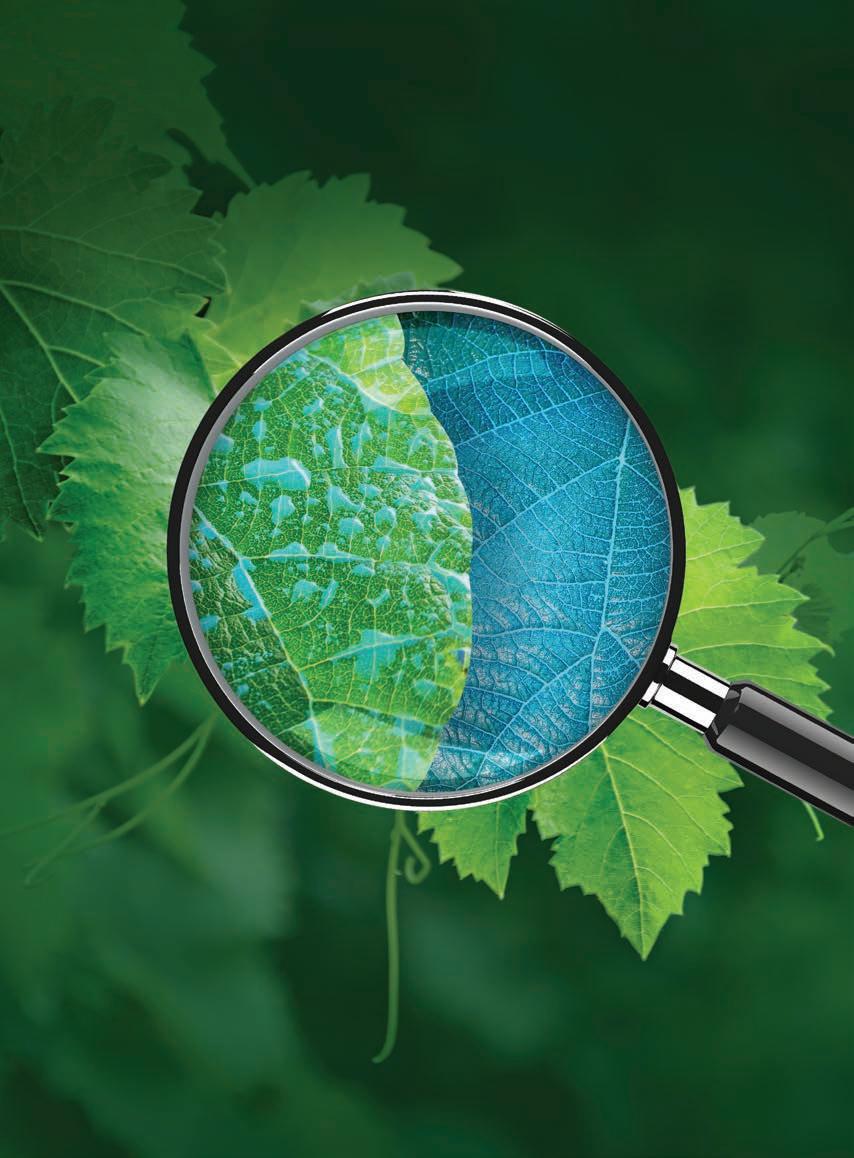
With increased row density and more trees planted per hectare, there is no doubt the UFO and FOPS systems are an investment for growers.
Cherri Global now uses the technology in Roxburgh, Alexandra, Bendigo, and Hawke’s Bay, as does the fully electric, zero carbon Forest Lodge near Cromwell.
In the first two years the work is labour intensive for staff, but the benefits of these planar canopies then start to pay off with only simple pruning requirements. “A bit like paint by numbers,” he says.
The main advantages of planar fruiting walls, through being able to optimise light interception, is the ability to produce various fruit types such as apples, pears and plums with reduced labour costs. Platforms can be used, therefore no ladder work is required, which attracts a wider range of staff. They also lend themselves to simpler rain covers and to advanced technology such as imaging, robotics and mechanisation.
The future of horticulture and utilising new growing systems is just the beginning of a new era in the industry, where traditional methods of labour are now being advanced by the new world of technology.
“There are other growing systems being developed both here in New Zealand and offshore which also have potential to change the face of growing cherries and other crops. Albeit we stuck with conventional systems too long, it is great to see the innovation that is coming with the new growing systems and the introduction of scanning technology and mechanisation. It’s a fun time to be a grower.”
Earnscy Weaver and Caythorpe owner Simon Bishell amongst the UFO technology on the cherry orchard in Blenheim
30 The ORCHARDIST : OCTOBER 2023 YOUR INDUSTRY
Other growing systems have potential to change the face of growing cherries


®Flume is a registered trademark of Nufarm Australia Ltd. ONF208172NF For superior spray coverage use a super-spreader Optimise the performance of your crop protection with Flume® , the new super-spreader from Nufarm. • Superior non-penetrating coverage at lower water rates • Save water – spray larger areas on a single tank • When coverage is king, use Flume with copper applications For more information contact your Rural Supplier or Nufarm Territory Manager or visit us at nufarm.co.nz/flume Without Flume® With Flume®
Supporting young orchardists
When Grant McKay moved to Cromwell there were no support groups for young people in the horticulture industry, so he set about getting one started, and from that the Central Otago Young Grower competition was born.
There might have been 25 to 30 people attending the prize-giving at the end of the first event back in 2015, with a casual barbecue to finish, but nowadays it’s a prestigious event, with 140 guests, a formal dinner, awards ceremonies and guest speakers. And it’s because of this passion for the industry and helping bring young people through, that Horticulture New Zealand recently recognised Grant’s work with an Industry Service Award.
Aimee Wilson
The only hint that he received about getting the award was when he was invited to the VIP table at the annual conference, and he wondered if it was because one of the other managers hadn’t shown up.

While surprised to be given the award, he said it was also an “honourable privilege” and nice to be recognised for the work he had put into young people in the district.
Starting out as a consultant for AgFirst in Nelson, Grant ran modules for the Young Grower competition in the Tasman region, and also participated in the Kellogg Rural Leadership Programme.
Feeling compelled and invigorated, he started the Tasman Young Grower group in conjunction with Kevin Withington and Andrew Kininmonth to help people connect more in the industry, a place where they could share their opinions without feeling intimidated.
32 The ORCHARDIST : OCTOBER 2023 YOUR INDUSTRY
Grant McKay receiving his recent Industry Service Award from Minister of Agriculture Damien O’Connor
He then moved south and started a Central Otago group back in 2014, in conjunction with growers Tim and Nick Paulin. The group had more than 35 members, and is a combination of both viticulture and fruit growers. At its peak there have been up to 45 members, “open to both sectors for a bit of variation and sector crosspollination,” he says.
The horticulture industry has been very good to me
The Central Otago Young Grower Competition was launched a year later and now he’s handed it over to technical advisor Mariette Morkel who is learning the ropes as he once did. Mariette is a recent graduate of the Horticulture New Zealand Leadership Programme. “It is great to be able to give another up-and-coming leader the opportunity,” he says.
“I think people over time have recognised the value of bringing young people into the orchards,” Grant says.

Particularly over the last decade, young people are becoming really valuable and their skills are hard to come by. “The opportunities are there, you just have to put the work in.”
“We lose a lot of young people because they just don’t want to be spraying and picking or pruning all day. Owners have to provide diversity.”

Grant’s Industry Service Award was presented for his work in going beyond the call of duty to provide significant service to the industry over many years.
By reviving the Central Otago regional competition, he also turned it into a high calibre event and attracted not only more participants but sponsors as well.
The Central Otago Growers Group now governs itself, much like the Young Farmers groups around the country. In the past there have been site visits to other orchards and vineyards, and to the NIWA (National Institute of Water & Atmospheric Research) base at Lauder – “to show there are a lot of opportunities in the horticulture sector.”
It’s also about the ability to go and have a chat with someone else about a topic that might be useful, such as grafting or disease.


“It is certainly changing and challenging the young people coming through the ranks. There is a need to mentor and coach people into the industry,” Grant says.
Because he’s been there once himself. Initially brought up in North Otago, Grant admits he’s always been a bit of an ‘urban’ person, but that didn’t stop him studying a Certificate in Horticulture at Otago Polytechnic’s Cromwell campus back in the early 1990s.
Realising he had a strong interest in horticulture, he ventured off to Lincoln University and completed a Diploma in Horticulture and a Bachelor of Commerce and has never looked back.
“The horticulture industry has been very good to me.”
There is a need to mentor and coach people
He has also maintained strong links with Otago Polytechnic, as the Bannockburn base is where the Young Grower finals are held in Central Otago every year.
Looking back on the start of the competition, it is clear that the Central Otago event is well established now, and the district has positively followed the same path as Tasman.
The ORCHARDIST : OCTOBER 2023 33 YOUR INDUSTRY
The future of horticulture is starting to look brighter, but there will always be both good and challenging seasons.
“We have 2D canopies happening which has led through to mechanisation and automation, and there’s some really good things going on in innovation.”
We don’t have the resources to fund these innovation projects
With Central Otago introducing New Zealand’s first commercial electric tractor at Forest Lodge Orchard, Grant believes there will be some great things that come out of that, adapted by the industry, and that will eventually become the norm.
The primary sector will always face issues around labour, and compliance costs, and there is still a lot of duplication around that.
“But some of the digital technology will reduce that duplication,” he says. Compared to Nelson where he first started his career, Central Otago has been slightly slower to see these advances–size being one of the reasons.
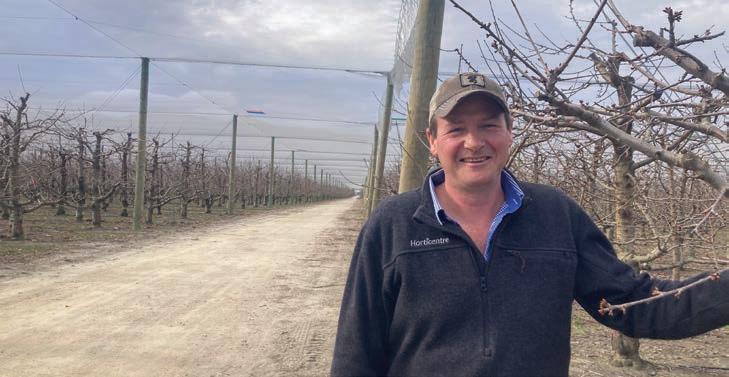
“The industry has picked up significantly and we’ve come a long way,” Grant said.
Central Otago doesn’t have as much opportunity for investment into research and development as other areas or sectors, “as we don’t have the resources to fund these innovation projects.”
This is where young people can help, as they are bringing not only new ideas but new ways of thinking into horticulture.
“The primary sector will always have hard times and good times, but that’s the nature of the industry. But horticulturalists are adaptable.”
Grant says at the end of the day there is a lot of satisfaction in bringing the next generation through with you, to help them succeed.
Grant is currently helping to mentor the Central Otago regional winner Greg Durand for his national competition at the end of October
Look at what’s been done with the Central Otago Young Grower competition – Mariette has now completed her leadership course and is running the event.
Grant will still be there. He’s currently helping to mentor the Central Otago regional winner Greg Durand for his national competition at the end of October.
Horticentre Group regional manager Grant McKay at home in his job in Cromwell
34 The ORCHARDIST : OCTOBER 2023 YOUR INDUSTRY
YOUNG GROW ERS
Congratulations to all six finalists who took part in the 2023 Young Grower of the Year national final in Pukekohe this October.
Please contact Kerrin.Burns@hortnz.co.nz for 2024 sponsorship opportunities. Dates for the 2024 competition will be released in the coming months. Visit www.younggrower.co.nz for more detail.




A SPECIAL THANKS TO ALL OF OUR 2023 SPONSORS:






NATIONAL FINAL 2023
PLATINUM SPONSORS
GOLD SPONSORS BRONZE SPONSORS SILVER SPONSOR SUPPORTER SPONSOR PRIZE MONEY SPONSOR PLATINUM SPONSORS
Is it time for pineapple growing in New Zealand?

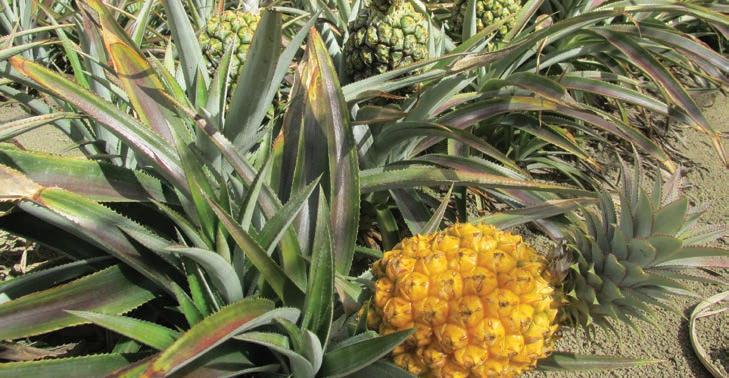
With some orchardists and dairy farmers now diversifying into growing bananas, pineapples are also starting to come into focus. Since Covid-19, there has been an increasing interest in sourcing locally grown food with a known story, and this includes tropical fruit as growers explore what else might thrive in our subtropical regions in a potentially warming climate.
New Zealand’s only commercial pineapple growers, Owen and Linda Schafli, have grown and harvested thousands of pineapples near Whangarei in recent years as their project comes to fruition.
“We harvested our first sizeable crop in 2021 after seven years of building up our plant numbers,” Owen says, “and the fruit is much loved by our customers. We’ve run out of land here with 1.3 hectares
Wendy Laurenson
in pineapples, so now that we’ve proved they can be a viable crop in warm areas in New Zealand, we’re ready to share our knowledge and plants with other potential growers.”
“We would like to encourage commercial growers to diversify into pineapples on their existing kiwifruit, kumara or dairy farm properties, especially if they have suitable machinery for planting in mounds. While we
36 The ORCHARDIST : OCTOBER 2023 YOUR INDUSTRY
Ripening Queen pineapples, a small gourmet variety that is super-sweet, golden yellow and has an edible core
know pineapples can grow here in warm Northland sites, other coastal regions like Gisborne and Bay of Plenty are also potential locations.”
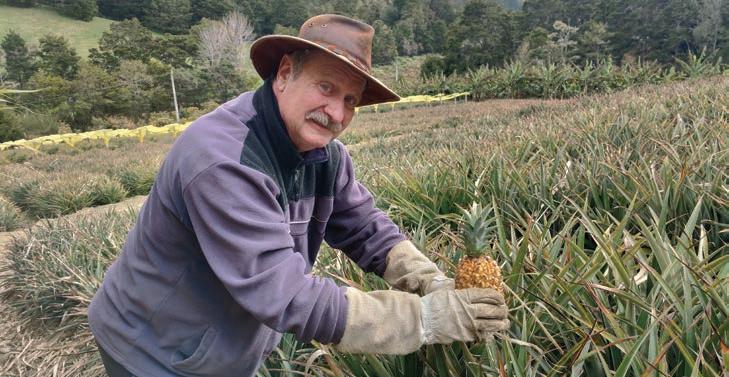
Owen Schafli grew tropical fruit in South Africa before the family moved to New Zealand in 2008 and later bought property near Whangarei to grow mainly bananas and pineapples.
“We initially planted several banana varieties for a cash crop while we experimented with growing pineapples,” Owen says. “We bought the first plants from a friend, trialled them in mounds on our higher ground, and when we knew they would grow and fruit well we started taking suckers to build up plant numbers, and preparing the land
for planting to make the best economic use of our sloping property.”


When the Schaflis were propagating from every small sucker, the plants took two to four years to flower, but their mature plants now provide a good supply of larger suckers that will flower in one to two years, with a further few months until pineapple harvest. By the end of 2021 they had 40,000 pineapple plants in the ground and have since increased their numbers to nearly 50,000.
Part of Schalfis’ pineapple growing success is their choice of the Queen variety. It’s a small gourmet pineapple that is super-sweet, golden yellow, has an edible core, a good shelf life and multiplies faster than some varieties.
Owen Schafli says he has shown that growing pineapples in New Zealand is viable. Photo courtesy of the Schaflis
The ORCHARDIST : OCTOBER 2023 37 YOUR INDUSTRY
It’s an old cultivar still grown in Australia, India and South Africa for fresh fruit rather than canning. It also has a better tolerance of cold, disease and stress than Cayenne, the main commercial pineapple variety grown worldwide and imported here.
Pineapples are seldom irrigated where they are grown commercially in the tropics, but they do need enough moisture for the developing fruit to fill out and mature. “Ideally pineapples love a hot wet summer,” Owen adds, “but so far we’ve managed to get away without irrigation. Northland is usually humid, and because our crop is year-round we’re not dependent on one season’s weather. We initially had some root rot problems which we’ve now solved with good hygiene, and we’ve managed to stay spray free.”
“Cayenne is well suited for large scale harvesting and processing because the big fruit fit the cans with little waste,” Linda explains. “The plants are usually sprayed to induce uniform flowering and harvest times, and are picked unripe then gas ripened for fresh fruit export. We chose Queen to give New Zealanders the option of a super-sweet locally grown pineapple that is spray free and available nearly year-round.”
Pineapples like warmth, protection from frost, rich slightly acid soil, and free-draining ground, and they’re slightly more cold-hardy than bananas. “They’re in the bromeliad family so they like humidity but they hate wet cold ground,” Owen explains, “so we plant the suckers straight into mounds in October when the ground has warmed up. We can plant four rows in one mound for optimal land use without crowding the plants, and we protect some of the lower blocks with frost-cover during the cooler months.”
There are very few pests and diseases affecting pineapples in New Zealand, partly because our cooler climate doesn’t sustain those that are common in the tropics, and partly because there are fewer host plants for them to thrive on. Imported pineapples also now have their leafy tops removed to reduce the biosecurity risk from supermarket fruit being used by insect pests as a source of plant material.

Because our crop is year-round we’re not dependent on one season’s weather
Kiwifruit or kumara growers are well placed to diversify into pineapples, especially if they have suitable machinery for planting in mounds
2021
40,000 pineapple plants in the ground
Now 50,000 pineapple plants in the ground
38 The ORCHARDIST : OCTOBER 2023 YOUR INDUSTRY
Queen pineapples are small, super-sweet, and golden yellow
The Schalfis’ whole operation, including picking, is done by hand because of their sloping land and lack of space. “Pineapples are reasonably easy to harvest despite their prickly leaves,” Owen explains, “and we’re able to sell them here with the tops still on. For early harvest in March or April we wait until the fruit is fully orange before picking it, but in August and September we pick as soon as there is a bit of orange to prevent the core going brown, then it colours up in about a week.”
From one hectare you will have replacement stock for five hectares

Interest in New Zealand grown pineapples increased dramatically after the Schaflis’ enterprise was featured on Country Calendar, and the exposure helped people realise pineapples could grow outside here. “We regularly sell at the Whangarei Growers’ Market where we were
originally known for our bananas,” Owen adds, “and there’s now a huge interest from our customers in the Queen pineapples. We usually sell out, and at our production peak of 700 pineapples at one market last May we sold out by 9.15am, and that was with a limit of six fruit per customer, so we know the market is expanding.”
Owen explains that pineapples will provide a return in one to two years, with the first fruit being the biggest. “After six years mature plants are usually dug out, but they will provide enough suckers for five times the original area, so from one hectare you will have replacement stock for five hectares.”
Linda and Owen have recently been joined by their son Colin, and their focus is now on gearing up to take orders later this year for growers interested in mature Queen pineapple plant suckers for planting in October 2024. “We anticipate selling a minimum of 40,000 plants per grower, ideally to plant at 40,000 plants a hectare, plus we’ll provide knowledge about growing them. We’re keen to support what could become a new small industry.”
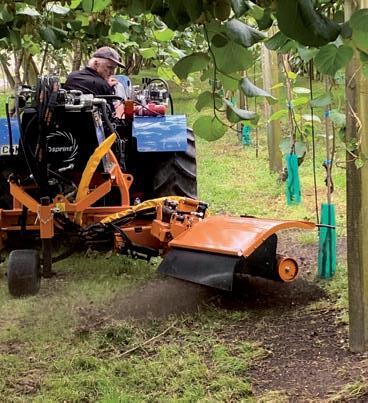
© Copyright 2023 Farmgard Ltd. All rights reserved. Specifications are subject to change without prior notice. CONTACT US NOW FOR A DEMO ON YOUR ORCHARD.
CALL FARMGARD 24 HOURS 0800 FARMGARD FIND OUT MORE AT farmgard.co.nz Nationwide Dealer Service Network 35 years, Generations of Experience BERTI ECOSPRINT KIND ON PLANTS. A commercially viable alternative to sprays which won’t damage trunks or plants. The ORCHARDIST : OCTOBER 2023 39 YOUR INDUSTRY
The Berti Ecosprint has a patented rotor with 8m of nylon per spool, which can be easily extended when worn, and will tackle the harshest of weeds without damaging the trunks or plants.
Otago grower moves into heritage plums
A member of one of Central Otago’s pioneering orcharding families has decided to move into heritage fruit growing –planting greengages on his new orchard on the foothills of the Dunstan Mountains.
Aimee Wilson
Dennis Paulin is one of a long line of fruit growers in Central Otago. His 98-year-old father can still tell you a few tales of his own from the good old days, when tractors were luxuries more than an everyday tool to help you in horticulture.

Dennis bought his first block of land in Earnscleugh at just 19 years old. He went on to own several, but now he is moving up behind the Clyde Dam beside his younger brother Tim Paulin – who operates Three Kings Cherries, including a large packing operation.
The Paulin family celebrated a century of harvesting summerfruit two years ago. Dennis is a grandson of Robert Noel Paulin (known as Noel), who established an orchard just outside Clyde in 1921. Dennis’ older cousins
Kevin and Raymond own and operate the Clyde Orchards along with their wives.
There are also three sisters in the mix as well, and eldest sister Kathy Forrest bought the family orchard from their father, Des.
Their brother Kenneth also owned an orchard on Dunstan Road, and Uncle Frank was relocated off his orchard when the Clyde Dam was built, and moved to another in Manuherikia.
Primarily an organic grower at the well-known Denny’s Orchard, which is currently on the market, 90 percent of Dennis’ product has been BioGro certified – including nectarines, peaches, cherries and apples.
40 The ORCHARDIST : OCTOBER 2023 YOUR INDUSTRY
Brent Hill Contracting and team planting out new greengage trees on Dennis Paulin’s new orchard in Central Otago
Dennis Paulin has been working with greengages for a few years on one of his old blocks
He figured out the only way to make any money in pipfruit was to export organic apples, and he has been doing that for the past 15 years.
What he loves about fruit growing is planting young trees and observing how well they perform.
“Especially if you manage to select a variety that really performs outstandingly.”
A great orchardist, Dennis believes, is someone who has good observational and communication skills. “The exceptional ones are also very good businessmen.”
Dennis has been around long enough to see huge change in the district. Historically there had been more than 200 growers here. Now there would be probably less than 50.
“Now we have an area of orchards rather than orchardists. We have less people doing it on more land.”

Orcharding has never been easy. Dennis’ first block was planted in Moorpark apricots, and it got flooded out that year. There have been many lessons to learn along the way.
“We started off with the good tasting ones, then moved to the good looking ones, and now we’re breeding for both good looks and taste characteristics.”
In the 1980s he decided to go overseas and work on big orchards in the United States. That’s where the name Denny’s came from, it wasn’t just a nickname for himself like many would have thought. California must have made quite an impression on him. He jokes that the only mistake was coming back.
The 65-year-old has seen some big advancements in fruit growing since he first started. In the 1960s it was forklifts, then overhead sprinklers for frost fighting, then windmills.
Nowadays, the big developments are coming from new varieties of apples and apricots, through different



More often than not Dennis sees researchers and orchardists doing something that they tried 30 years ago.

Est 1956 L.E. Cooke Nurseryman Ltd Ltd L.E.
quality
trees your fruit tree Try us first for requirements! Marty & Kelli Cooke 75 York Road, Longlands, Hastings, 4120 PH: 06 870 7043 EMAIL: lecooke@xtra.co.nz CELL: 0274 396 205 (Marty) Proudly serving the fruit industry for 67 years •Pears •Plums •Apples •Apricots •Cherries •Peaches •Nectarines www.lecooke.co.nz
Cooke Nurseryman Growers of high
fruit
The ORCHARDIST : OCTOBER 2023 41 YOUR INDUSTRY
They’re a hard crop but easier to maintain
He remembers his grandfather Noel being the first one in the area to get rubber tyres on his tractor. He started out using horse and cart to work the orchard and spraying using a hand pump.
“It was hard, heavy work.”
Rabbit lines were put out to make extra money when times were tough, instead of social welfare. Research was “at the pub on Friday night learning from each other’s mistakes.”
Technology has sped up the orchard systems dramatically. Today there are commercial tree planting tractors that use Russian satellites to guide them.
Brent Hill is a contractor around Central Otago and was involved in helping Dennis with his new greengage crop.
The tractor can plant out 300 trees an hour, and annually his figures have been upwards of 100,000 trees – mostly cherries and grapes.
Dennis has been working with greengages for a few years now down in Earnscleugh on one of his old blocks, and has kept persisting to make them grow.
There are several other heritage plum growers popping up around the district as well, particularly as the demand for the old-style fruit is making a comeback domestically.
“They’re a hard crop but easier to maintain. They need a certain amount of chilling hours over winter.”
His advice to someone starting out in the industry is to consult with those who have been around a long time.
“More often than not they will know something that will make a significant difference. Purely because they have experience.”
In an ideal fruit growing world Dennis says, it would be awesome if all the cherries were just flown straight out the district in abundance, “that we were big enough to be cleared for export.”
90 percent of Dennis’ product has been BioGro certified
Some people worry that there are too many big corporate companies moving into Central Otago, planting out huge areas of cherries, but Dennis says it is nothing compared to what he saw in California.

“Efficiencies are the biggest problem here. We’re competing with other countries in the world where the cost structure is way lower than ours. We’ve become uncompetitive.”
At the end of the day, it’s about who has the reputation for producing the best tasting fruit. Dennis says he can’t go past a good quality organic piece of fruit, followed by a top quality crunchy Central Otago cherry.
“A good quality organic piece of fruit is not manipulated with that growth promoting, artificial nitrogen.”
And due to its dry climate, Central Otago is the ideal place to grow organic produce.
42 The ORCHARDIST : OCTOBER 2023 YOUR INDUSTRY
What Dennis Paulin loves about fruit growing is planting young trees and observing how well they perform (pictured with the Brent Hill Contracting team)
Understanding the cyclone’s impact on apple orchards
In response to Cyclone Gabrielle, scientists from Plant & Food Research have been collecting data from apple orchards in Hawke’s Bay. Working with industry body New Zealand Apples and Pears, the aim is to better understand the impact of the event on tree and soil health and support growers’ management decisions, now and into the future.

The Soil Health – Assessment and Recovery Project has involved working with about 30 orchard owners and managers to study the effects of silt and waterlogging on apple blocks. These orchards have now all been visited twice, initially 15 to 30 days after the cyclone and then three months later. A grower survey was also completed as part
Supplied by Plant & Food Research
of this work. A third visit to these orchards is planned this spring, allowing scientists to continue tracking changes in soil and tree health and gain insights into how recovery efforts are progressing.

Project leader, Dr Stephen Trolove, said that there was a wide range of impacts of the cyclone on growers, from very few trees lost to some flood-
affected blocks losing all of their trees. In these initial surveys orchardists reported the greatest number of tree deaths in young trees or small trees on shallow-rooted, low-vigour rootstock. Two key sediment types were identified on silt impacted orchards – sandy sediment deposits and finer textured deposits consisting of silt and clay particles. Stephen said the
The ORCHARDIST : OCTOBER 2023 43 YOUR INDUSTRY
Stephen Trolove and Jim Walker on a Hawke’s Bay orchard
fine textured sediment appeared to seal the soil surface, causing the water to perch in the sediment. This saturated sediment was slow to drain and dry out and soon ran out of oxygen, indicated by a colour change to blue-green grey (a process called gleiing or gleying). This prevented the movement of oxygen to the roots in the soil below.
by thin layers of fine sediments within the sand sealing soil pores.
“To our surprise, below the sediment layer, the original soil appeared largely unaffected – it wasn’t waterlogged or gleyed. The presence of some larger air-filled pores in the soil will have aided tree survival. The amount of air stored in the soil below the sediment varied depending on the depth of the water table, which was anywhere from 23 centimeters to greater than 100 centimeters below the original soil surface two weeks after the flooding in the blocks we assessed,” he said.
“Even if you managed to scoop up the sticky stuff, you may not be able to tip it out of the digger bucket. Some growers had to wait for blocks to dry a bit, or wait for machinery or drivers before they could remove the sediment.”
To our surprise, below the sediment layer, the original soil appeared largely unaffected
Stephen said sandy sediment showed a range of responses, some had drained by two weeks, allowing air movement to the soil below. Other sandy deposits were still waterlogged after two weeks and had become gleyed, which may have been caused
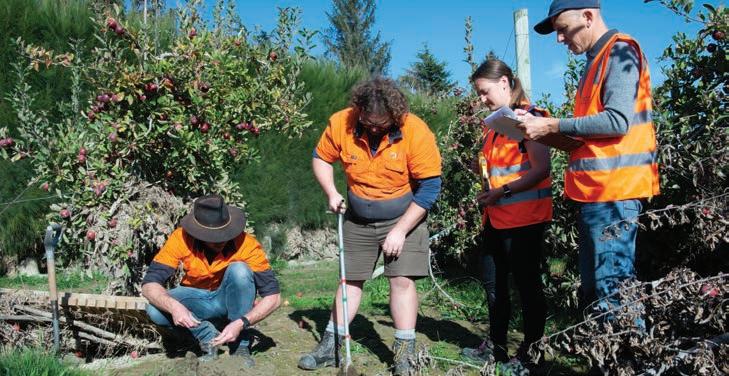
Stephen said growers had several weeks or so to remove this waterlogged sediment from around mature trees before a decline in tree health was seen, although nursery trees were dead in less than two weeks. The deep, sticky waterlogged sediment made it extremely difficult or impossible for growers to get machinery around the orchard. All growers had to weigh up the economics of sediment removal.
While up to 750 hectares of orchards were silt-affected, a much larger area was impacted by flooding, causing widespread waterlogging in soil. Stephen said in some areas water was ponded for up to six weeks, with other growers mentioning that their orchards were waterlogged all season. These waterlogged conditions will affect the root health of apple trees.
“Damage to roots takes time to visually appear. We expect this to be evident in spring when trees go through another period of stress
The focus must be orchardists protecting their long-term investment and making management decisions that will set them up for multiple seasons of productivity
44 The ORCHARDIST : OCTOBER 2023 YOUR INDUSTRY
The project’s soil team undertaking data collection
brought on by bud break, flowering and fruit set, then we’ll have a better picture of the extent of the impact waterlogging has had on trees in the region,” he said.
since the cyclone, said fungicides were being utilised by growers to stimulate plant defenses and try to minimise damage from root diseases.
Jim said the soil-borne pathogen Phytophthora, a root rot, was a key concern, as under extremely wet waterlogged soil conditions it may have caused a lot of damage to roots. He said some trees impacted by root rot would need to be nursed along and would struggle to produce the loads they had previously been able to carry. Pruning is one part of managing crop loads, but it would largely need to be managed through thinning.
“Damaged root systems cannot carry as big a crop – if you try to then you risk the health and the future of the tree, especially if El Niño brings drought this summer. The focus must be orchardists protecting their long-term investment and making

management decisions that will set them up for multiple seasons of productivity.”
Jim said that prior to the cyclone, a well producing tree might have been carrying 500 to 600 fruit – but trees with severely damaged roots might only be able to carry a third of that load in the coming season.
“It will be important for growers to understand what variation in the water table there might be on their orchard and how long the trees might have been waterlogged. Low spots will likely require more thinning for tree survival to be maximised,” he said.
“We know growers have already put a huge amount of effort into getting their orchards back to good health, and growers are going to need to keep making good management decisions during this next phase of the recovery.”
 Dr Jim Walker, who has led Plant & Food Research industry engagement
Dr Jim Walker, who has led Plant & Food Research industry engagement
Communication with onsite contractors made easy Zero Harm is simplif ying health and safety onsite Find out more on www.zeroharm.app 0800 005 345 support@zeroharm.app The ORCHARDIST : OCTOBER 2023 45 YOUR INDUSTRY
While up to 750 hectares of orchards were silt-affected, a much larger area was impacted by flooding
Demand for apple trees could build to a perfect storm
Anne Hardie
The apple industry has reached an “inflection point” as Hawke’s Bay growers work towards replanting after the cyclone, new players begin planting in Canterbury and many orchards need to be renovated with newer varieties.

That is the summary from Waimea Nurseries chief executive officer, Bruno Simpson, who says this time of change will also put pressure on nurseries that need commitments from growers early enough to plan for future plantings.
He estimates between 1.5 and 3.5 million trees will need to be replaced in Hawke’s Bay following Cyclone Gabrielle, though “frankly, we just don’t know”.
“The industry can accommodate that, but only if we get commitments to plant. Our concern is that when the industry is ready for these replacements, we are not going to be able to deliver them when they want them. Just the volume of trees that could be required could put significant strain on the industry.”
At the same time, there is now considerable interest from new players to plant in Canterbury, and Bruno says those players are looking at significant volumes of trees, and large blocks of land.
“You end up in a situation where it could be a perfect storm of growing demand due to other activity at the same time Hawke’s Bay wants to replace and renovate – because they really do need to start renovating the orchards in Hawke’s Bay – and the nursery industry will struggle to deliver trees in a timely manner.”
He says that is still a couple of years away as Hawke’s Bay is still in clean-up mode, but growers need to be in discussions with nurseries and not necessarily signing contracts, so nurseries can plan ahead.
Many growers in Hawke’s Bay are still waiting to see how trees fare through spring if they have survived the flood but sat in silt, he says.
In Canterbury, the apple industry has been relatively smallscale and the nursery’s commercial and group marketing manager, Kate Marshall, says the latest developments are driven by investors looking for large blocks of land which are not available in traditional growing areas.
“The availability of large blocks of land and the cost of that land is more available and more affordable in Canterbury, and it is a good growing area for apples when you compare it with other growing regions around the world.”
To date, Bruno says a significant chunk of Canterbury’s fruit is transported by road to Nelson each year to be packed and shipped.
“One of the keys to unlocking Canterbury will be investment in large-scale post-harvest, and it will come.
“I certainly see a pathway for Canterbury to grow to Hawke’s Bay size or even exceed it. It’s just the availability of land.”
The difficulty for Canterbury is that it can never be first to the market with its fruit, so will depend upon varieties that are reliably high-priced throughout the growing season and need the reliability of supply, he says.
“I think it is positive for the industry to be looking to more diverse growing areas. In the likes of a cyclone, it isn’t going to impact everywhere, and if you want to continuously deliver product into a market every year, one of the challenges is that they need to have a good continuous supply even in years when they have a weather event. And we know there will be more and more weather events into the future.”
Bruno Simpson and Kate Marshall say the industry is in the midst of change
46 The ORCHARDIST : OCTOBER 2023 YOUR INDUSTRY
Beyond new plantings in Canterbury and replanting areas affected by the cyclone, Bruno says Hawke’s Bay orchards have much-needed renovation work to do. For a decade, growers nationwide have been investing in new orchards, which has expanded the planted area, but he says there has not been aggressive redevelopment of existing orchards, especially in Hawke’s Bay. One of the reasons is that older varieties have still been slightly cash positive or at least neutral, until costs began to ramp up in the past couple of years.
Tasman, on the other hand, has not had land for expansion, and growers have fewer options in market access and timing, he says. That has forced them to focus on delivering fruit really efficiently by being more aggressive in their move to orchard mechanisation and new planting systems. He says the industry needs to be renovating at least three to five percent of its plantings each year – on average – which would put it on a 20-year replacement cycle that keeps orchards modern and current, but that has not been happening. Renovation may mean replacing ten percent of an orchard one year when returns allow, but nothing the next year to achieve that replacement cycle.
“When we’re planting back in Hawke’s Bay in particular and renovating, it has got to be focused on good genetics for both varieties and rootstocks, as well as for modern mechanisable and future pedestrian-friendly orchard systems.”
He says there is no point planting lots of trees in systems that do not meet the cost expectations into the future or address labour management.
“The biggest question growers have for us at the moment is, ‘okay, I know I need to do something, but what variety should I plant?’ And at the moment it is a challenging question to answer.
“The challenge with our international varieties is we’ve been working very hard for a number of years to improve the importation pathways, and so frankly had a backlog of new varieties that we’ve wanted for a long time. They’ve already been superseded by new genetics coming through the later part of those pipelines.”
Bruno says many of the new varieties have been bred and developed overseas and imported into New Zealand with the intention that New Zealand will form a key part of global supply plans. He is positive they will provide options for growers in the next few years, along with new varieties bred in New Zealand that are coming on stream or waiting in the wings to be launched.
Some of those varieties in the pipeline will be adaptable to climate change or targeted to the markets New Zealand services the most, such as Southeast Asia and the Middle East. Many are commercially available already on the global market, but have yet to be proven in New Zealand growing conditions, and it will be two to three years before any fruit can be observed. He acknowledges it is a challenge for growers to select varieties.
“Growers must be the world’s most optimistic people. They plant a variety in the hope that in 15 years’ time it will still be profitable and in demand. You have to be an eternal optimist to be a grower, I think.”
As we all know, in the fruit growing industry ultimately everything stems from a twig. We have alliances with some of the world’s best new fruit variety developers and rootstock breeding programmes. These relationships and our continual search for the best cultivars puts us at the forefront of global variety and rootstock development in New Zealand.








Our unique capability across a wide variety of crops and our focus on matching varieties and rootstocks to conditions allows us to offer real, informed advice. Call:
Kate Marshall, 0274 201 033, kate@waimeanurseries.co.nz
Jeff Sandford, 0274 201 003, jeff@waimeanurseries.co.nz

In our world of twigs and roots pedigree is everything.
www.waimeanurseries.co.nz
The ORCHARDIST : OCTOBER 2023 47 YOUR INDUSTRY
Between 1.5 and 3.5 million apple trees will need to be replaced in Hawke’s Bay following Cyclone Gabrielle
Optimism for organics as flood recovery turns to reset
Talking to John Bostock was something of a reprieve from what has been six months of doom and gloom reporting on horticulture in Hawke’s Bay. The optimism and positivity he projected took me by surprise, but was also quite refreshing.
Bonnie Flaws
John says he’s in reset mode, looking at the business operations, culling varieties and introducing new ones. Bostock certainly took a hit in the cyclone, losing about 90 percent of its onion crop, and some apple blocks have either come out of organic production or leases have been discontinued.

He’s spent a fortune on the clean-up and has accessed the government’s loan scheme for growers, which has been helpful. But he says what the industry needs now is capital. Perhaps his optimism comes from the fact that the organic market continues to grow globally.
“We want to get on the front foot and we’re very positive about organics, the market seems to be growing everywhere. We want to build a cash war chest from the opportunities that are out there.”
This translates as selling down shares in the business, and John says he has had ‘incredible interest’ on that front. Despite his optimism, he says organics isn’t for the fainthearted.
“You’ve got to be a better grower than average. You have got to understand the soils and the pest relationships, and you’ve got to be nimble. What is absolutely incredible
Despite taking a hit in the cyclone, John Bostock is optimistic about organic growing in New Zealand
48 The ORCHARDIST : OCTOBER 2023 YOUR INDUSTRY
John Bostock salvaged and exported about 70 percent of his apple crop
is that we produced a big crop in probably the most difficult conditions you could get for organics. The whole of 2022 it rained from beginning to end, culminating in a massive cyclone, and we produced a viable crop. That is a remarkable performance.

“We salvaged about 70 percent of our apple crop and exported it. And we’re back to 100 percent this year – our production was growing anyway but we’ll be up to about 1.2 million boxes of organic apples next year, for our export apples.”

Bolstering his organic horticulture and cropping is the organic chicken business, Bostock Brothers, fronted by his two sons, George and Ben Bostock. The chooks graze in the apple orchards and contribute to the orchard lifecycle.

The market for chickens is so strong most weeks they can’t meet demand. As the only organic chicken producers in New Zealand this is not surprising, and the chooks are even exported to places in the Pacific, Asia and the Middle East. But on the orchard side of things, it appears that the organic apples have perhaps been a bit more resilient in terms of coping with the extreme weather. John says the fact that organic producers have abundant live biology in the soil has been a positive, and he’s noticed that the trees are looking really healthy.
“Things are looking great actually. We have predominantly 202 rootstock, which is a little bit more vigorous because of the organic system.”



06 879 5883 office@biobees.co.nz www.biobees.co.nz Need some bad weather insurance? Darker, Colder, Wetter, Windier, Done. The ORCHARDIST : OCTOBER 2023 49 YOUR INDUSTRY
Organic apple growers Craig and Wendy Dowling report similar results on their Haumoana and Meanee blocks. They lost about 20 percent of their crop from wind and rain, and the orchards were badly waterlogged – and one was two feet deep in water for about ten days – but they didn’t drop their crop.
“So we were very very lucky. Craig has been in there pruning and they don’t think they’ve found any dead trees, but it’s going to be quite interesting to see what our blossom is like over the next few weeks,” Wendy says.

As organic growers they weren’t able to use fungicide or other synthetic products, while conventional growers were able to spray with choppers while trees were still sitting in mud and water.
“We just had to hope. It was late enough in the season that primary and secondary infection risk was for the most part gone. Blackspot wasn’t too much of a concern for us and we were not too far from harvest.
“We did get the rest of our crop off and we were pleasantly surprised at the quality, and it was received into the market well. And our later fruit grew really nicely and our pressures were really good – that crunch factor.”
Wendy says because organic growers don’t use fertiliser sprays to pump the fruit up, the organic apples are denser. Furthermore, the trees seemed to be more resilient in that severe weather. “Our pressures didn’t drop either and others’ did. They went from perfect to falling.”

But it wasn’t all plain sailing, Wendy and Craig had to do some deep ripping and power harrowing for serious repair work on tracks and inter-row. She points out that no grower wants compacted soil but they had no choice but to drive on wet soil for the last two years, which had resulted in major ruts.
Affected blocks smelled “like death” for some time after the storm with all the anaerobic activity, and there were dead earthworms everywhere. But they now have everything back in good order and are waiting on blossoms and fruit setting to see what shape the trees are in. “Who knows –Craig thinks the buds looks big but I don’t know if he’s just being optimistic,” she laughs.
On the market front however, they have had to tighten up on who they work with now in order to protect profits. While growers don’t generally get much say in what fruit sells for, this year they decided only to work with buyers that could provide a minimum guarantee as an indication of what they will be able to pay. As a result they’ve had to drop exports to the United Kingdom, which was the market for Braeburn.
50 The ORCHARDIST : OCTOBER 2023 YOUR INDUSTRY
Organic growers Craig and Wendy Dowling lost about 20 percent of their crop but the rest of the waterlogged orchards seem to have fared all right
It was costing them $50 a box to grow but they couldn’t sell them for a profit. “We’ve just made the call to not even go there. The American market has been quite strong. Taiwan has been strong. We’re excited to be dealing with a new buyer in America, Viva Terra, who are organic growers themselves and have been in business for 30 years. They’ve been great.”
Back at Bostock, John is also trialling a new variety called T47, and has SugarBee® coming from the United States.


“We’ve got a whole raft of exciting IP (intellectual property) that we want to transition to and the market is really excited by it. Dazzle™ is a runaway success and it’s replacing other varieties – right across Asia we’re getting incredible support for it. As owners of the variety, we are not allowing any new plantings and we’re not going to over-plant it. We’re learning how to manage it and we’re probably going to stem clip the whole crop.”

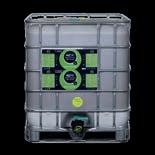
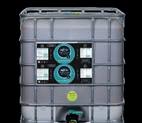


As well, Bostock is planning big volumes of Marron d’Or squash, and all the onions are in the ground early this year. Ground conditions are fantastic, he says, with only light irrigation needed at this point.
Export costs had also come down from $15 a box to $12 and they’re exporting about 50,000 cartons, with more plantings coming into production this year, she says. While their Braeburn crops have had to be pulled up as they can barely be sold outside of the United Kingdom, instead they’re trialling some new varieties.

John says he is more positive than ever. “That’s why I’m going out to the market. As the sole owner I’ve built a very large business, and now it’s time to go to the market and take advantage of that opportunity. I just see growth and excitement.”

0800 SEAWEED (0800 732 933) www.agrisea.co.nz AgriSea NUTRITION For all your Horticulture needs Soil NUTRITION • Increases root mass & length • Unlocks trace elements & micronutrients in soil • Improves soil structure & water-holding ability • Increases soil microbial activity • Easy to use Ocean NUTRITION • Deeper humus layer • More natural nitrogen fixation • Assists plant nutrient uptake • Certified organic Nitrogen, Potassium, & Phosphorus source, 100% natural. Improved soil structure Foliar NUTRITION
Enhance colour in foliage • Increases brix levels • Aids resistance to pests & disease
Easy to use
•
•
We just had to hope. It was late enough in the season that primary and secondary infection risk was for the most part gone
The ORCHARDIST : OCTOBER 2023 51 YOUR INDUSTRY
Circular business delivering benefits for clients and environment
Shelly O’Shaughnessy is proud when she sees fruit and vegetables attractively displayed in supermarkets and fruit and vegetable stores –not because she’s a grower, but because the company she works for most likely supplied the containers, bins and crates the produce is in.
Elaine Fisher
Shelly is director of sales and support services for CHEP New Zealand, part of a global company which is among the pioneers of the circular business model.
“My kids get tired of me pointing out our products in store, but I’m proud of the services CHEP offers and that what we are doing is important for the future of our children’s children, the community and the environment,” says Shelly who is a member of Women in Horticulture.
The business model for CHEP New Zealand, which celebrates its 50th anniversary next year, is based on the concept of share and reuse, also known as pooling. Customers access
the products (pallets, crates, bins, containers and more) from CHEP on a rental basis, reducing upfront capital costs.
Globally CHEP manages, maintains, transports and supplies more than 350 million platforms that are shared and reused by growers, manufacturers, distributors and retailers.
In New Zealand, collectively the supermarket chains and CHEP have achieved major reductions in supply chain environmental impacts. More than 11 million reusable CHEP crates are in circulation, transporting fresh produce from farms to retail stores across Aotearoa, and replacing the equivalent in single-use cardboard boxes.
 Shelly O’Shaughnessy is director of sales and support services for CHEP New Zealand
Shelly O’Shaughnessy is director of sales and support services for CHEP New Zealand
52 The ORCHARDIST : OCTOBER 2023 YOUR INDUSTRY
What we are doing is important for the future of our children’s children, the community and the environment
“Almost any foods you see in New Zealand supermarkets have arrived on one of our products. In the pallet world we have about 90 percent of the market in New Zealand. Once pallets have reached the end of their lives, they are recycled into chips for children’s playgrounds.”
In her role with CHEP, Shelly works with some of New Zealand’s biggest companies, including the large FMCG (fast moving consumer goods) businesses, markets and retailers, but also with individual growers including small family businesses.
My kids get tired of me pointing out our products in store
“I know how important it is for growers to have the right products they need at the right time, to harvest and transport their produce, so we are continually innovating to reduce waste and keep costs down.
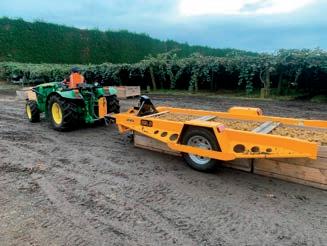
“The biggest thing in a business which is nearly 50 years old is to keep disrupting our own model with innovation, before others do. We are currently working with growers and retailers on an end-to-end fresh programme including temperature control and track and tracing to improve product quality, which affects growers’ bottom line.”
Another aspect of working for CHEP which appeals to Shelly is that it partners with sustainable foresters. “We have a policy of ethical sourcing for all our products. Share and reuse is in our DNA.”
Shelly’s role is an example of the diverse career opportunities the horticultural industry offers, and it’s one she did not envisage for herself as a teenager.

“I grew up all over the place, but mainly in Auckland and Australia. My high school education was in Christchurch, and I endured a Bachelor of Education at Canterbury University. Upon graduating, I realised teaching was not what I wanted to do.”
But says Shelly, that degree has not been wasted. “Studying taught me persistence and routine, and about how people learn and develop, which has helped me in my role of coaching and helping develop people in my team.”
Shelly’s CHEP team is diverse and that’s the way she likes it. “We have graduates and high school ‘early leavers’, people of different race, colour, religion and sexuality and I wouldn’t want it any other way. Each brings different strengths to our team. Diversity of thought is vital to our organisation.”
Shelly has been with CHEP for just over six years, and in her current role for 12 months. Previously she has worked in a number of other industries, mostly in customer relations. Shelly has five children, four boys and a girl, aged between nine and 23 years. “With three children still at home, an unpaid Uber driver is my second job, along with being involved in their school activities, but I love it. Family and health must always come first.
“My dad, Alan, taught me not to sweat the small things and not to go to sleep with a bitter taste in your mouth about work or relationships. I tell my team at work that if you get those things right, work and life will flow so much better.”
To join Women in Horticulture, visit: www.unitedfresh.co.nz and follow us on LinkedIn: women-in-horticulture


In-house engineer designed and Built to last, simple but very strong design Double acting hydraulic forks Rated 1 500 tonne capacity Jack stand, safety chain Tyre spats and full LED lighting package for on road towing www.maintracservices.co.nz 07 533 1983 NOW AVAILABLE LANDMAC ORLO A1500 3 BIN HARVEST TRAILER Give us a call for more information built in the Bay of Plenty The ORCHARDIST : OCTOBER 2023 53 YOUR INDUSTRY
Nothing is better than a balanced diet
Scientific research is continually identifying the health benefits of individual fruits and vegetables but there is no one ‘super food’, says Dr Carolyn Lister of Plant & Food Research Limited.
Elaine Fisher Photos courtesy of Plant & Food Research
“Certain foods are good for certain things such as blackcurrants which can help in sports recovery, blueberries for brain health and broccoli which may help reduce the risk of certain cancers, but the most important thing is to eat a balanced diet,” says Carolyn who is a principal scientist and leads the food and health information team at Plant & Food Research and is a member of Women in Horticulture.
Carolyn, based in Lincoln, just out of Christchurch, has spent close to three decades researching plants and their beneficial properties for human health. Today she leads a team which manages the New Zealand Food Composition Database (foodcompostion.co.nz) and conducts research to understand the factors impacting the nutritional and phytochemical composition of a range of foods and some animal feeds.

“We also work with companies to develop nutrition and health claims for foods and to promote greater consumption of plant-based foods. A key developing area of research is centred on nutritional sustainability, nutrition sensitive agriculture and regenerative agriculture impacts on food quality.”
In the 1990s, when Carolyn began her PhD studies, research into plant pigments and human health was

 Dr Carolyn Lister principal scientist and lead of the Plant & Food Research food and health information team and a member of Women in Horticulture
Dr Carolyn Lister principal scientist and lead of the Plant & Food Research food and health information team and a member of Women in Horticulture
54 The ORCHARDIST : OCTOBER 2023 YOUR INDUSTRY
Dr Carolyn Lister of Plant & Food Research Limited with scientist Sarah Morrison researching the nutritional benefits of broccoli
relatively new and exciting. “Thirty years ago, much of the work in that area was to find a ‘magic bullet’; the plant pigment which would deliver the greatest health benefit. But the realisation now is that different plants deliver different benefits through their unique composition of compounds, delivering wellness and health in the broadest sense, rather than to prevent or cure one particular disease.”
Carolyn, who grew up in Ashburton and then Blenheim began working with plants almost as soon as she could walk. “My parents were both English teachers and we were a ‘townie’ family but always had big vegetable gardens. I still have a scar from when I was about two and tripped and broke a jug I was using to water plants, cutting my hand.”
That experience didn’t deter Carolyn and as she went through primary school, she entered gardening competitions. It was winning a Third Form (Year 9) college science fair award from the then Department of Scientific and Industrial Research (DSIR) that inspired Carolyn to commit to a career in science.
“When I won the award, I decided I would one day work for the DSIR.” Soon after leaving the University of Canterbury with a BSc (Hons) in plant biochemistry, Carolyn was employed by the DSIR where she completed her PhD studies investigating the skin colour of apples and how it could be manipulated to appeal to the Japanese market.
In 1997 Carolyn gained a fellowship at the University of Glasgow. “That fuelled my interest in the role of plant pigments in human health. The international experience, working so closely and connecting with other researchers, was invaluable and I am still in touch with many of the people I met then.”
However, New Zealand was home so Carolyn returned to continue her research into plant biochemistry. That research has covered a wide variety of crops including tomatoes,
potatoes, lettuce, blackcurrants, green tea, broccoli sprouts and Californian poppy.
The diversity of work includes commissions from companies seeking to establish the nutritional benefits of their products, and some prompted by her personal interest.
“The initial work I did on blackcurrants and their health benefits came from a conversation with a colleague at the pub one evening.”
While Carolyn doesn’t spend as much time in the lab as she did earlier in her career, there’s always something new to discover about the benefits of plants which keeps her motivated and enjoying her work. “I also love interacting with academics and the general public, and I’m passionate about communicating science to the community.
“I think communication has become even more important in recent years to combat some of the misinformation and disinformation that’s around and to demystify science so that people can better understand and are able to use scientific information.
“I enjoy working with school students and the 5+ A Day education programme to promote an interest in science and nutrition,” says Carolyn who is a member of the board of trustees for 5+ A Day.
Science wasn’t high on the list of careers for young women when Carolyn was at college, but she is pleased that more women are now entering the field. “We need diversity within the science community, and I think women bring a slightly different perspective to the field.”
To keep up-to-date with Women in Horticulture, its news and activities, and join the membership database, email info@women-in-hort.nz
Everyone is welcome.
•Self levelling tracked boom 12m height, Lithium/Briggs

$63,000 + GST ex Penrose
•Tracked scissor lift, 8m height Zero turn, can climb to 40% $26,200 + GSTex Penrose



Email: sales@landex.co.nz

Ph: 0226 188 456
 Orchard Crawler Boom
Orchard Crawler Scissor
Orchard Crawler Boom
Orchard Crawler Scissor
The ORCHARDIST : OCTOBER 2023 55 YOUR INDUSTRY
APPLES AND PEARS UPDATE
Plenty of growth potential in apples and pears
Karen Morrish : New Zealand Apples and Pears chief executive
The Orchardist asked newly appointed chief executive Karen Morrish to share her thoughts about apples and pears. From her previous roles as an independent consultant and group health and safety, compliance and sustainability manager at Scales Corporation and Mr Apple, Karen joins the industry body with significant governance experience.
She currently sits on the international GlobalG.A.P. advisory board and various local boards, and was a New Zealand Apples and Pears board member from 2019 to 2020.

What excites you most about your new role with New Zealand Apples and Pears?
I’m incredibly proud to be leading the New Zealand Apples and Pears team. We are a small team of industry experts who punch above their weight, both in New Zealand and around the world. And I am very pleased I get to continue to work in an industry I am passionate about, and alongside a wonderful community of people committed to producing the best fruit in the world, in the best way possible.
What should be the next government’s number one priority to support apples and pears in New Zealand?
We need the right policy and regulatory settings to support our growers to grow fruit. Growers need an environment in which they can productively operate, providing employment, supporting regional economies, food security for New Zealanders, and contributing to export success. This includes improvements to the Recognised Seasonal Employer (RSE) scheme, market access, the Environmental Protection Authority (EPA), and water and land settings.
Do you see positives emerging from this difficult year to date for many orchardists?
What makes you optimistic about the future?
It’s been a tough year for growers, from cyclones devastating our crops to increasing costs and regulation and compliance. We are optimistic about the future because we must be. We have the best apples and pears in the world, and demand for our fruit from international markets is there. Personally, the wonderful young people coming through the industry inspire me about the future; the future is certainly in good hands.
Pipfruit has been hard hit by weather events in the North Island. What does Grow Back Better mean to you?
Recent weather events have had a huge impact, and yes, we will grow back better, but we are an industry that is always growing and improving, year to year. The apple and pear industry has a key role in building a more sustainable, productive and inclusive food sector, but this needs to happen with government support, and a commitment to move beyond aspirational statements and strategies, to implement practical measures to make it work for growers.
Is pipfruit too focused in Hawke’s Bay?
Would it be better to increase hectares in other parts of the country?
New Zealand is a great place to grow pipfruit, many places across the country are suited to growing, and to growing specific varieties. There’s lots to learn from emerging areas and to learn from new climates. Our industry has the opportunity to grow – given the right conditions, we could be a $2 billion industry, and I am sure that this growth will be reflected across the country.
When you’re not eating apples and pears, what is your favourite New Zealand-grown produce?
I’m an avid home gardener, with multiple vegetable beds and a glasshouse. For me, there is nothing better than serving homegrown produce – everything I grow is a favourite!
Online Orchard Irrigation Supplies Call our experts 0800 130 905 www.irrigationexpress.co.nz 56 The ORCHARDIST : OCTOBER 2023 YOUR INDUSTRY
New NZAGA executive elected
Matthew Ball : NZ Avocado marketing and communications manager

The New Zealand Avocado Growers Association (NZAGA) has recently elected an entirely new Executive to lead the industry.

Following a recent voting process, industry stakeholders have chosen Alistair Young, Andrew Darling, Anna St George, Blair Morris, and Carol Palmer as the newest members of the NZAGA Executive, with Alistair Young elected as chair and Anna St George as vice-chair. These individuals bring diverse backgrounds and extensive experience, providing a solid foundation for addressing the challenges and opportunities that lie ahead. With great confidence, the newly elected Executive is united in its pursuit of a common vision for industry success.
“There is much to do over the coming year as we deliver on the support that growers need from their industry organisation,” says Brad Siebert, who is stepping into the role of acting chief executive with nearly a decade of involvement in the industry. As consumer preferences shift, supply chain dynamics evolve, and global markets fluctuate, the industry will require strong governance and ongoing engagement with growers to pave the way for a resilient avocado industry in New Zealand.
The voting turnout at the election was sensational, and great thanks go to all the candidates who ran for election, as well as the growers who voted, as it instils optimism about the number of people who are actively engaged and interested in the future of the industry.
Growing avocados can be a difficult occupation, especially when the weather impacts the industry as it has in recent years. However, avocado growers are both resilient and optimistic about the future. Challenges often breed solutions and there is a lot of collaborative thinking taking place on orchard and through the post-harvest sector to bring value back to the grower.
While global avocado production has increased at a rapid pace, avocados remain one of the fastest-growing fruit categories in the world. Avocados stand out as a credible natural source of health and nutrition that connects to many of the important consumer trends driving growth in food. Looking ahead, the industry’s focus is to provide a growing number of markets with high quality avocados, while also supporting a thriving domestic market in New Zealand.
Increase beneficial biology in orchard soil and foliage with Mycorrcin and Foliacin



For bigger roots, higher nutrient uptake, sturdier more resilient trees and higher quantity and quality fruit.

AVO UPDATE
0800 116 229 biostart.co.nz
and is also available in organic form.
Brad Siebert is stepping into the role of NZAGA acting chief executive
Available from leading horticultural retailers,
The ORCHARDIST : OCTOBER 2023 57 YOUR INDUSTRY
Soil systems
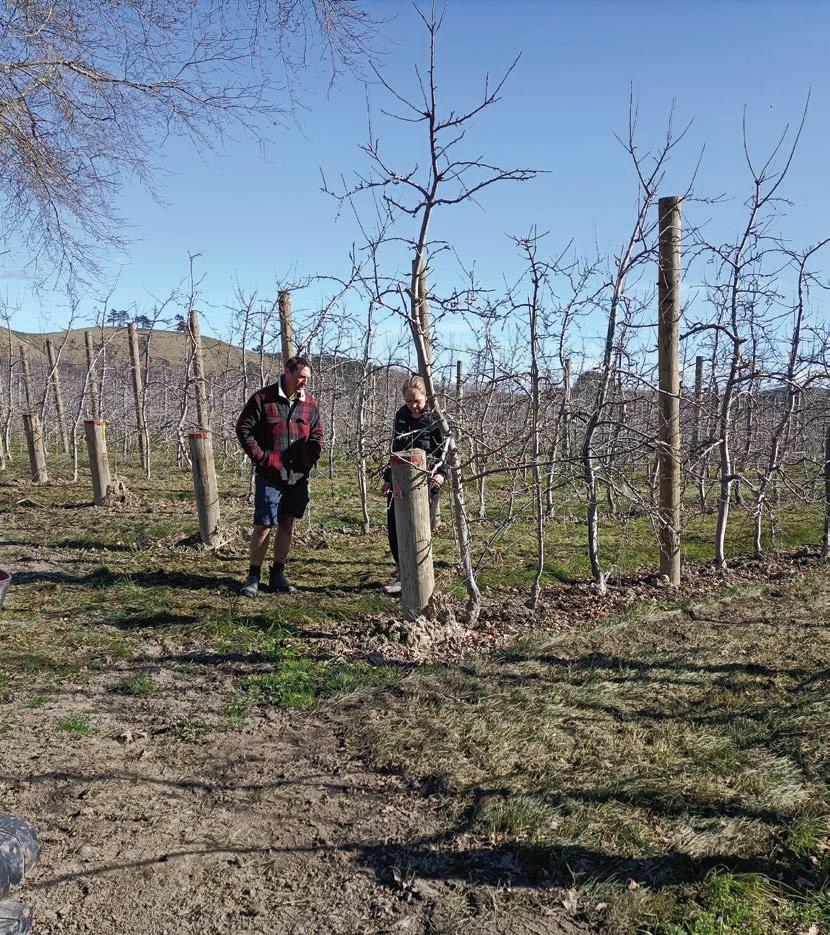
TECHNICAL
THE LATEST INNOVATIONS AND IMPROVEMENTS
Page 64
National Policy Statement for indigenous biodiversity –Know your land
The National Policy Statement for Indigenous Biodiversity (NPSIB) was gazetted on 07 July 2023 and came into force on 04 August 2023.
Carl O’Brien : AgFirst Consultants Hawke’s Bay
The NPSIB is specific to terrestrial biodiversity and developed to provide a direct response to decline in indigenous biodiversity, aiming to protect, maintain, and restore biodiversity across New Zealand. The NPSIB sets out a consistent approach to identify Significant Natural Areas (SNAs) and fold these into nationwide protection. It might appear at first glance primary production is not directly impacted; however, orchardists should be aware that the contents of the NPSIB could bring attention to activities including spraying and irrigation.
1.1 What Qualifies as a Significant Natural Area?
An area is determined to qualify as an SNA where it meets any one of the following four criteria in the context of an Ecological District assessment:
• Representativeness;
• Diversity and Pattern;
• Rarity and Distinctiveness; or
• Ecological Context.
While determination by a suitably qualified ecologist will likely be required for Council purposes given the complexity of assessment, landowners do know their land and can take stock of what they know is present.

The ORCHARDIST : OCTOBER 2023 59 TECHNICAL
Figure 1 Example of Wetland Area within an Orchard Block that could trigger SNA classification (Courtesy of Google Earth)
Similarly, District Plans already identify a range of significant sites and these lists can be utilised as guidance for landowners. By checking whether areas within or adjacent to your landholding are already mapped and recognised, the proximity of such sites can be gauged, and scope given on the types of landforms considered important when considering your own site. Beware however, prior to the NPSIB District Plan terminology is not consistent across the country with terms including Outstanding Natural Features, Outstanding Natural Landscape, or Significant Ecological Area utilised. These will generally all be encompassed within the NPSIB SNA definition.
1.2 Implementation
Implementation will be via district councils or territorial authorities (with support from Regional Councils where requested) with NPSIB requiring district wide assessments to be undertaken to identify all areas that qualify as SNAs and include these within the next appropriate plan or plan change notified. Notifications of plans or plan changes must be within eight years of the NPSIB commencement date. Where district councils and territorial authorities have been proactive, I expect resource consent applications will form the priority pathway for identifying potential new SNAs. This will be via an increased level of scrutiny within new consent applications to ensure that the NPSIB has been considered and sufficient detail provided within applications. From a practical point of view, water take and use applications, discharge applications, etc will require an increased level of detail to be submitted covering the full land holding to ensure the NPSIB is given effect.
2.0 Implications for orchardists
You may be thinking that is all very well and good, but does it really impact on orcharding, or primary production given that the policies provide recognition for activities that contribute to social and economic wellbeing as well as established activities? As always, the devil is in the detail.
... change also affords opportunities for continuous improvement
From my perspective, the primary concern for growers is the overarching provision for any Significant Natural Area already identified, recommended for protection, or to be identified following territorial authorities’ review and implementation of the NPSIB, to be automatically included and subject to these provisions with or without landowner input. This would mean that if an area within a piece of land meets these thresholds, it could be rolled into a heavier layer of protection without any further consultation or consideration for onsite activities. While we all support maintaining, protecting and enhancing indigenous biodiversity, if rolling an area into heavier protection conflicts with existing operation, constraints may emerge. Understanding the features of your land against the necessary site operations is integral to determining what level of impact an additional layer of controls may present. An example of an area that may be automatically rolled into protection is shown in Figure 1 on the previous page.

60 The ORCHARDIST : OCTOBER 2023 TECHNICAL
Figure 2 Cross Boundary Issues – Example of a Braided River Environment adjacent to Orchard Blocks (likely considered an SNA) with standard headland allowance. Is this level of buffer appropriate to avoid impacts from an already established activity?
2.1 Orcharding activities that may be subject to additional control
It is feasible that a raft of ‘normal’ site practices may fall subject to the provisions of the NPSIB including:
• Water takes (existing and new applications): While any new application, or renewal on an overallocated source (both surface and groundwater) may be subject to the NPSIB requirements to ensure an SNA isn’t adversely impacted, existing takes may also fall under scrutiny where adverse effects are suspected. All resource consents contain a review condition and where an adverse effect is identified or suspected, this could be triggered should adverse effects be suspected (i.e. draining a nearby wetland). In Hawke’s Bay, the Ngaruroro River for example is already recognised as an Outstanding Natural Feature and while the TANK (Tūtaekurī, Ahuriri, Ngaruroro and Karamū water catchments) Plan Change process includes a sinking lid on new water takes to address over allocation, meaning renewals will face additional scrutiny to ensure the provisions of the NPSIB for maintaining and enhancing are met.
• Damming and diverting of water: Establishing a new dam or diverting water to provide for irrigation activities will need to consider the location at a landscape level as to the implications on indigenous biodiversity.
• Tile drainage: While installation of new tile drains has, in some areas, been under the spotlight for draining wetlands and altering hydrological patterns, the NPSIB may have a twofold impact via considering whether altered hydrological patterns present an adverse impact on indigenous biodiversity as well as the nature, extent and quantum of discharge into a receiving environment.
• Extension of spray buffer zones: Reverse sensitivity and recommended buffer zones to address adjacent sensitive landuses are provided for within good and best practice farming programmes while many territorial authority planning documents also provide a specific
Packhouse & Orchard Equipment for Sale

We have sold our packhouse so need to clear everything out.
We are located in Nelson but can organise freight across NZ
Packhouse Equipment
Lynx 4 lane grader with singulator, 20 drops, electronic upgrade 2021
��18x Tray fillers- 12x 600mm wide, 6x 400mm wide
��Lynx 6 lane grader with singulator, 7 drops with colour heads
��2016 Compac Rotofiller 3 and sorting table
��Early Rotofiller 3 and sorting table with electronic upgrade 2023
��MacDonalds Rotary bin filler
2x FHS hydraulic tilt bin fillers and feed belts
buffer zone for more sensitive landuses. Nominally, these are for adjacent residential houses or permanent water courses, however where an SNA is present adjacent to an orchard block, the provisions may require additional buffer where sprays may impact fauna (insects, lizards, birds, aquatic life etc). (Refer Figures 2 & 3 .)
2.2 Additional Areas of Consideration
Additional aspects of the NPSIB to be aware of include:
• Use of woolly language or terminology yet to be fixed within case law or precedent. In example ‘established activities’ is a new term, appearing to provide for existing use rights, but leaves ambiguity over permissible or authorised activities that are not fully implemented. Some industry groups (i.e. mining) have indicated they will challenge the regulations, leaving some further uncertainty as to what implications may arise from new terminology;
• Implementation of a precautionary approach. While consistent with wider policy direction, NPSIB terminology weights decision-making processes to be even more conservative. The justification being that existing provisions are not creating appropriate outcomes, so additional direction for enhancing indigenous biodiversity is needed. From an orchard perspective, this approach could create implications over time via changes to permitted activity rules, increased set back distances, or reductions in water allocation;
��3x FHS flap fillers
��2007 Sorma RMS pallet strapper


Waxing plant
��Rotary table
FHS hydraulic twin bin tipper forklift attachment
��Carton conveyor systems and carton printer
��Custom hydraulic bin dump, infeed conveyors, sorting tables and twin air knifes
��Multiple belt conveyors and elevators
��Lots of misc packhouse equipment
Orchard Equipment
���Nblosi Zip30 platform with bin track system
Tow and Blow 250H portable frost fan

1000x Fruit Bins
1200Wx1150Lx600H
Treated Orchard Posts –
3.6m ¼ rounds, 4.2m rounds,
1.8m rounds
���Foam bin liners
Understanding the features of your land against the necessary site operations is integral to determining what level of impact an additional layer of controls may present
Please email workshop@thawley. co.nz for
more
The ORCHARDIST : OCTOBER 2023 61 TECHNICAL
viewings or
details/photos.
• Reduction in population size or occupancy is rightly noted as a significant adverse effect and in the case of highly mobile species impacted, little option may be available except for offsetting impacts on another area of land;
• All biodiversity is protected via the prescribed management hierarchy meaning that areas outside of SNAs will still be afforded higher levels of cover than currently provided under the status quo;
• Regional Councils are mandated to target of at least ten percent indigenous cover for all urban and non-urban environments. This hard target may be difficult in areas where existing horticultural activities is concentrated i.e. Heretaunga Plains and Gimblett Gravels in Hawke’s Bay;
• Monitoring is to be completed regularly across SNAs by territorial authorities, which can impact on day-today operations within a dynamic environment. While growers have the right to refuse Council access, this removes an important chance to participate in the process and contribute context.
3.0 Addressing conflicts & opportunities for landowners
Primary production activities are integral to social and economic wellbeing so while frustration is understandable regarding additional regulation and costs in a challenging economic climate, change also affords opportunities for continuous improvement and to be world leading. Environmental improvements should be gradual, tailored to individual sites, and avoid significant impacts on operations (i.e. financial hurdles).
Staged improvement actions can include:
• Fencing and riparian planting of drainage networks and channels in a staged manner. Hardy flax species (harakeke), cabbage trees, Juncus etc all provide environmental improvements. Plantings can be rolled out as existing infrastructure requires replacement or repair in manners that don’t compromise operations;
• Considering drainage pathways within individual blocks or properties for re-establishing wetlands and ponds where balance can be achieved against productivity, costs and benefits;
• Assessing opportunities for reducing herbicide and pesticide applications. Simply ensuring any necessary applications are efficient via calibrated and wellmaintained equipment and applied using best practice guidelines can yield reductions and economise the significant cost of chemical applications while contributing to productivity and environmental benefits;
• Assessing the need for herbicide applications, and considering alternatives such as sward covers under orchard rows that can provide benefits i.e. nitrogen fixing, beneficial pollinators, soil recovery, erosion protection etc. Any reduction in herbicide use contributes to productivity and environmental benefits;
• Considering layout and design of orchard blocks when undertaking replanting or maintenance operations. Is a standard 10m headland depth appropriate for the features and adjoining landuses? Or can planting be adjusted to balance the needs of greater separation from features of significance against less sensitive areas;

62 The ORCHARDIST : OCTOBER 2023 TECHNICAL
Figure 3 Spray Buffer Zones – Standard 10m headland (pink) and extended 20m headland (green) highlighting implications of potential requirements for additional buffer zones
• Ensuring water use is as efficient as possible via water budgeting for irrigation, ensuring irrigation systems are maintained, and ensuring that all operators are appropriately trained for minimising waste. Should opportunity exist to undertake improvements via fencing or planting, don’t forget to reach out to the local Regional Council and investigate opportunities for discounts and funding. Many Regional Councils have catchment specific objectives and can offer subsidies via discounted plants or other assistance. Similarly, a variety of other organisations exist (i.e Biodiversity Hawke’s Bay) where funding is available.
3.1 Understanding and Mapping Your Land
Having an appropriate detailed and scaled map identifying orchard blocks, infrastructure and features provides an easy cross reference for management actions within any primary production activity. The level of detail required should be determined by the operational processes of the farm and could be a simple aerial image showing the property boundaries, and farm system areas. For more complex sites, a Farm Environment Map may be required to show different crops, features, and limitations to ensure sufficient detail is readily available. Many operations will already have a Farm Environment Management Plan or will be looking to the requirements of Freshwater Farm Plans which should form the basis of informing what, if any, actions may be necessary regarding indigenous biodiversity.
Factors to identify when compiling or reviewing a Farm Environment Map regarding indigenous biodiversity include:
• Location and extent of permanent and ephemeral waterways, including overland flow paths and critical source areas;
• Presence of any wetlands, swamps, or poorly drained features that may not be contributing to the productive components of the farm;
• Areas of remnant bush, forest or scrub;

• Natural landscapes including tussock and dune;
• Features on directly adjacent properties that may trigger any of the above and the distance of these from operations.
When these components are assessed against the existing provisions of the applicable District Plan, landowners should have a foundation to determine what features are present within their operation, and therefore can develop a framework of any site-specific considerations.
4.0 Summary
The intent of the NPSIB is to maintain and enhance indigenous biodiversity at a landscape level across New Zealand, via a series of policies designed to reinforce the existing regulatory framework. While admirable, resource use does not exist in isolation, so while water take requirements, change in landuse, and nutrient leaching may all come under the effects umbrella on indigenous biodiversity when considering resource consents, orcharding is well recognised for its role in local and national economies.
As it is impossible to assign weighting towards these conflicting goals and values, landowners should not view all rules and regulations as a burden, rather use the opportunity to reflect and assess where improvements in operations can be implemented. Improvements do not always have to come at a cost, for example improvements in spray efficiency and efficacy can often be reflected in improved bottom lines. Similarly, riparian planting and use of beneficial species can reduce the requirements for herbicide application while providing long lasting environmental capital. Consultation is currently being undertaken on a biodiversity credit system and the NPSIB also requires Council’s to consider incentives for projects in priority areas and on specified Māori land which could provide an additional source of funding and collaboration for on-farm actions.
No decision should be made in isolation so it is important to consider what site-specific actions will deliver within both the farm system and wider ecosystem.
POLLEN
kiwifruit
PREORDER / ENQUIRIES: 021 795 830 rtpollen@xtra.co.nz The ORCHARDIST : OCTOBER 2023 63 TECHNICAL
Male
pollen
Facing forwards
Back in April, we raised the idea that management of a disaster often ends up being more important than the disaster itself. The short to medium term planning and management of the orchards in Hawke’s Bay and Tairāwhiti has been an ever-evolving endeavour for both cyclone affected orchards and blocks dealing with the remnants of the saturated season that was 2023.

Now with spring well upon us, it is important we reflect on how the recovery process has gone to date, and what still needs to be done as we prepare the 2024 crop.
The winter months have been a waiting game before we can fully understand the impact of the damage caused by Cyclone Gabrielle silt and debris deposits and saturated soil systems. Orchard management plans need to be updated as spring progresses and we can see how the trees respond during bud break and early bloom. By using the visible symptoms on orchard as well as the available technology, growers can make some good decisions about block viability, care and maintenance when adapting management plans heading into the 2024 season.
Key considerations to provide robust information required for management plan adaptions include:
1 Reflection on the actions already undertaken.
2 Above and below ground symptoms.
3 Understanding the full picture by utilising the tools available.
Reflect on the actions already undertaken:
We need to understand the implications of all the tasks completed since the cyclone (during the period of ‘disaster recovery’) and then determine how we are going to further respond to optimise the long-term health of our canopies, and secure a crop for the 2024 season.
Meg Becker : AgFirst Consultants Hawke’s Bay
64 The ORCHARDIST : OCTOBER 2023 TECHNICAL
This will highlight any ongoing challenges on orchard as well as any gaps or urgent tasks that need to be carried out. What tasks outside of business as usual still need completing before proceeding with setting the 2024 crop? Have the tiles been cleared, structures been fixed, silt been removed, and are you able to get machinery on the ground?
It is also important to consider if any of the tasks carried out during the ‘disaster management’ phase have caused underlying stress points that also need to be rectified. For instance, where blocks had to be cleared of silt and debris, this has meant repetitive machinery movements over saturated soils. This can create compaction in the inter-row, occasionally leaving behind a hard, concrete-like surface. Consequently, many blocks will need ongoing maintenance to improve their ground conditions, such as ripping, and careful selection of pasture seed mixes to regain soil health in the understorey.
Regardless of any water stress the trees have been under, if the usual post-harvest and winter orchard management has been ‘put on the back burner’, this could impede the 2024 cropping potential and overall tree condition and should be accounted for in management plan adaptions.
Business as usual tasks that could impact future crops include but are not limited to:
• Post-harvest nutrient programme execution

• Winter pruning timing, implementation, accuracy and completion

• Orchard husbandry and general winter repairs and maintenance (fixing orchard structures, cleaning out irrigation systems and ensuring functionality)

www.grochem.com Stop fire blight reaching it’s target with Blossom Bless™ Think ahead.
The ORCHARDIST : OCTOBER 2023 65 TECHNICAL
Figure 1 Unviable buds in cyclone affected block, winter 2023
• Replacement of missing trees
• Winter disease monitoring and canker removal walks.
What can you see happening above and below the ground?
Being able to quantify the level of stress the trees have been under will help interpret the cropping capability of the trees heading into the 2024 season. Up until spring we have been relying on anecdotal evidence to tell us what is happening with tree health and viability.
Bud Health and floral potential
Spring leaf growth and condition is driven by plant reserves that have overwintered. These reserves are largely influenced by the post-harvest nutrient uptake of the plant, and tree senescence, which we know was compromised right across Hawke’s Bay and Tairāwhiti during the 2023 season.
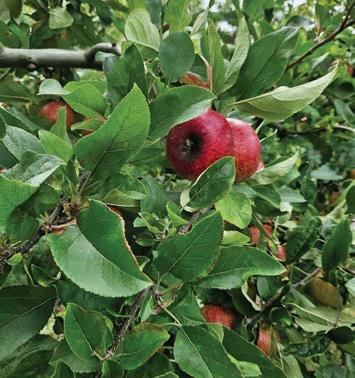
You may have analysed your floral bud health over winter, however, spring will provide more information around the quality of flower and highlight any stressed areas within blocks.
Within the AgFirst team we have carried out our own bud quality observations in severely cyclone affected blocks. We have seen a low frequency of floral bud rot, but the fact that this symptom is present at all is a concern.
Leaf Health
Early leaf supports flower clusters and fruitlets to set, followed by fruit growth and cell division. These early leaves are derived through the reserves the plant stored during post-harvest and autumn senescence. Due to the saturated soil systems, it is assumed that fine root hair growth in autumn and the reserves stored from postharvest senescence may be limited. It is likely that nutrient and winter reserve uptake was not optimised on blocks that experienced water, which could impact the quality of the early leaf supporting bloom.
If leaves are showing signs of yellowing or are of a reduced size, their photosynthetic potential may be limited, impeding carbohydrate production potential over the key cell division period. Yellowing may be due to low plant reserves and nutrient availability, or poor root health due to waterlogging.
Flower
Due to ongoing stress conditions, it is possible the pollination window may be shortened this coming season. This should be considered when working out your hive ratios and adapting your pollination plan. Flowers could be weak in areas that have experienced long periods of saturation, with wilting symptoms (similar to Fireblight) also likely to be seen in these areas.
In severely stressed blocks there is risk of poor fruit set, and in these cases the trees may only be capable of carrying reduced crop loads.
Soil Moisture Down the Profile 100 200 300 400 500 600 700 800 900 1000 0 10 20 30 40 50 Soil Depth (mm) Soil Moisture Content (VSM%) Full Point Trigger 02/09/22
Soil moisture profile September 2022 Figure 3 compared to September 2023 Figure 4
66 The ORCHARDIST : OCTOBER 2023 TECHNICAL
Figure 2 Canker rots expressing in fruit pre-harvest 2023
Fruit size and quality may also be impacted depending on pollination success, and the amount of inactivity in the root zone. This may be seen through misshapen, small fruit due to poor pollination, and risk of increased fruit russet incidence due to tree stress.
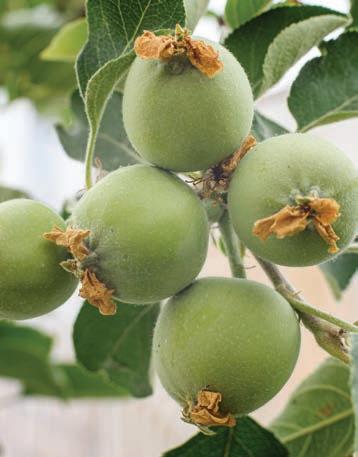
Pest and disease pressures


Observations before Cyclone Gabrielle noted a high incidence of canker across Hawke’s Bay. Managing and removing canker incidence should be of high priority and carried out using a best practice approach.
Phytophthora is likely to have a high incidence this coming season, with the potential for symptoms that didn’t express in autumn to come through this spring.
Overwintering blackspot, rots and other fungal diseases on mummified fruit and fruitlets left in the tree, especially on cyclone affected blocks yet to be pruned, will create huge disease pressures in the spring. Inoculum should be removed from the block, and accompanied by a tight spray programme in the spring.
Below ground symptoms
Keep digging holes and analysing the soil profile to better understand your site-specific soil health. The fine root hairs should be well and truly thriving by now, but if not it’s a sign of severe stress, and action needs to be taken to relieve the tree.
Getting air back into the soil structure around the root systems will be a key focus for Hawke’s Bay and Tairāwhiti growers this season – across all crop types.
www.grochem.com Inhibit russet from developing & promote new growth on young trees with Gib-47™ & Growth™
Soil Moisture Down the Profile 100 200 300 400 500 600 700 800 900 1000 0 10 20 30 40 50 60 Soil Depth (mm) Soil Moisture Content (VSM%) Full Point Trigger 05/09/23 Figure 4 The ORCHARDIST : OCTOBER 2023 67 TECHNICAL
Understanding the full system
Soil conditions, climate and poor drainage can be limiting factors to root health, particularly in blocks that have experienced long periods of waterlogging.

In Hawke’s Bay, many alluvial soils near rivers are considered ‘free draining’. These often have soil water tables that rise and fall with the river, however, river levels have been above average, causing these soils to remain saturated.
Although observed through visual tree health symptoms, understanding what is going on below the ground allows for better informed management decisions.
Irrigation readings
When was the last irrigation reading taken on your orchard and what was the soil moisture level? If your property was affected by flooding, how long has the soil been saturated? Are your artificial drains working? Impeded drainage or perched water tables would have exacerbated the issues caused by the 2023 season. Building a picture of the longterm soil moisture levels in your soil profile will be highly valuable in determining your block’s exposure to stress.
AgFirst’s soil moisture monitoring service has a considerable database on the soil moisture trends in Hawke’s Bay.
Our soil moisture data shows a full point through the profile down to one metre depth (field capacity), and a trigger point to show when further irrigation may be necessary.
The two soil moisture profiles shown on the previous page (Figures 3 and 4 ) compare the soil moisture content from early September 2022 and 2023, from a well-drained block
not affected by Cyclone Gabrielle. In 2023, the soil moisture content is roughly 10 VSM% above full point from 200mm profile depth right down to a metre. (VSM is volumetric soil moisture.) This particular irrigation tube has been monitored monthly all winter, and has been reading above full point since 1 April 2023, even though the property has sub-surface drainage. As expected, September 2022 shows a drier profile.
Root systems will be suffering from lack of oxygen, and as a result the root hairs are likely to be shallow and inactive. This means that when the soil profile does finally start to dry out, managing block irrigation is going to be important to ensure moisture levels are correct within the active root zone.
Soil tests and Leaf tests
Winter soil tests are likely to have been taken on orchard to determine any granular fertiliser application requirements prior to spring.
It is important we then validate the ability of the plants to uptake these nutrients by taking leaf tests in October. This will provide data which will enable a block-specific nutrient management plan to support tree health and enhance the 2024 crop.
Technology
Drones, cameras and disease mapping by GPS (global positioning systems) can be used to validate any visual observations made across your blocks. They are also great tools to highlight to your orchard management team areas that may need more attention.
68 The ORCHARDIST : OCTOBER 2023 TECHNICAL
Figure 5 Surface water, spring 2022
Drone imagery can be used to map flower, vigour and orchard stress, supporting crop load and canopy management decisions. The orchard management team can then efficiently ground truth the data, highlighting areas of the orchard where the 2024 crop may need to be reduced to support tree health.
GPS disease mapping is also a great tool to identify any disease hotspots. Any disease spread can then be monitored, allowing the management team to quantify if their disease mitigation strategy is working.
Production Data and pack-out report analysis


If you were able to harvest a crop in 2023, analyse the packouts. Look at fruit size outcomes and key defects. What were the causes of these defects, and what can you do to improve on these outcomes for next season to optimise income?

Canopy and Crop Load management
Setting realistic targets that reflect the level of stress each block has been under will be challenging. Growers will have to be vigilant in getting the crop load down to target early to relieve both floral and carbohydrate stress on the tree.

Just like during the 2023 spring, we will need to plan carefully when using chemical thinners. It is likely internal plant ethylene levels are elevated, so the reaction of the trees to chemical thinners may be heavy. Choosing the right chemistry as to not further exacerbate tree stress will be important.
There may be areas of the orchards that are showing such severe stress symptoms that for the sake of tree health, the crop should be aborted.
Missing and dead trees need to be quantified so replacements can be ordered from the nursery, but also to allow for appropriate crop reductions accounting for the loss of trees per hectare. A five percent reduction in trees means the t/ha (tonnes per hectare) target for the block needs to be reduced by five percent.
Orchard structure integrity must also be considered when adjusting crop targets. If there are still broken posts, collapsed canopies and unstrained wires, the trees won’t be supported to hold 100 t/ha.
If you are having to hold reduced crop loads, have a backup vigour management plan, so if growth does start to take off you are prepared and can act quickly.

When adapting your management plan, perspective is key. Understanding what factors are within your circle of influence is the first step to creating achievable actions. There are many variables that although we are unable to control (like the weather), we can have an impact on the severity of the outcome.
Our key drivers for this coming season should be to take actions that will restore long-term tree health in an economical manner, whilst optimising the 2024 crop.
Out of this world thinning performance with Meteor™ & BAPSoL 100™ www.grochem.com
The ORCHARDIST : OCTOBER 2023 69 TECHNICAL
La Niña to El Niño: From record wet to looming drought
 Ben Noll : National Institute of Water and Atmospheric Research (NIWA)
Ben Noll : National Institute of Water and Atmospheric Research (NIWA)

In our last update, we talked about the parts of Aotearoa New Zealand that had experienced record wet weather in the first half of 2023, driven in part by three years of La Niña. Now, just a couple of months later, the climate pendulum has swung all the way to an intensifying El Niño, with strength that may rival historically strong events that were associated with severe droughts.
Spring outlook: September to November
Conditions needed to officially classify El Niño were reached during September. Air pressure is forecast to be above normal to the northwest of Aotearoa New Zealand and below normal to the south, leading to more southwesterly quarter winds than normal across the country.
Spring rainfall is about equally likely to be near normal or above normal in the west of the South Island, and most likely to be below normal in all other regions. Spring may be marked by unusually long dry spells for several regions, owing to a combination of high pressure near the country and lower chances for atmospheric rivers.
Spring temperatures are most likely to be near average in the north and west of the North Island, and about equally likely to be near average or above average in all other regions.
Spring will come with more southwest winds and occasional outbreaks of cold air as well as episodes of warm-to-hot air from Australia, particularly in eastern areas of both islands.
A prevailing area of high pressure near the North Island may lead to clear, cold nights and mornings and the potential for unseasonable frosts. Seasonal wind strength is expected to be above normal, particularly when westerlies intensify, as predicted from the second half of September.
Coastal sea surface temperatures (SSTs) ranged from 0.1˚ C below average to 1.1˚ C above average during August. As El Niño becomes firmly entrenched in the climate system, the risk for the development of widespread marine heatwave conditions during spring is low.
Soil moisture is most likely to be below normal in the north and east of the North Island, near normal in the South Island, and near or below normal in the west of the North Island. River flows are most likely to be near normal in the west of the South Island and near or below normal for all remaining regions of the country.
Looking further ahead
El Niño is intensifying and signs are pointing to its strength possibly rivalling historically strong events. Previously, El Niño has been associated with some of New Zealand’s most severe, long-lasting and costly droughts. In addition, a positive Indian Ocean Dipole is rapidly developing; this was associated with the 2019–2020 drought, and is expected to reduce the risk for atmospheric rivers. Strong westerly winds are expected to be a theme in spring, summer and possibly autumn. Areas of below normal soil moisture were developing in eastern parts of both islands. With westerlies expected to blow stronger than usual in the coming months, conditions are expected to dry quickly. There is a long-term dryness risk for Northland, Auckland, Waikato, Coromandel, Bay of Plenty, Gisborne, Hawke’s Bay, Wellington, Wairarapa, Tasman, Nelson, Marlborough, Canterbury, northern Otago. This also brings increased fire weather risk.
Keeping track of forecast and outlook updates will be very important in the months ahead.
Predictions of temperature, rainfall, soil moisture and river flows. niwa.co.nz/outlook 70 The ORCHARDIST : OCTOBER 2023
NIWA SEASONAL CLIMATE OUTLOOKS
PROBABILISTIC PRECIPITATION TERCILE FORECAST


December 2023 – February 2024


NIWA and the Ministry for Primary Industries (MPI) are working together to develop a new drought forecasting tool. Recently launched, it uses innovative climate modelling, the latest in machine learning and other data-driven techniques. It is intended to help farmers and growers better prepare for periods of dryness and drought. The tool updates daily to provide forecasts at a much higher spatial resolution than previously available. You can look at the country as a whole or drill down into district-level predictions of dryness and drought. Check it out at https://shiny.niwa.co.nz/droughtforecast/

This image shows the regions of the country that have at least a 40 percent chance of below normal rainfall over summer. It includes much of the North Island and parts of the northern and eastern South Island


Want to know more about El Niño and La Niña and how they influence our climate? Scan the QR code or go to www.niwa.co.nz/el-nino.

Article sponsored by
NIWA AND MPI DROUGHT FORECASTING TOOL –PREDICTING RAINFALL AND DRYNESS 35 DAYS OUT
The ORCHARDIST : OCTOBER 2023 71
Honouring the mana and mauri of soil
Food producers face challenges across all sectors in New Zealand, and there is a common thread with almost all of them.
It is healthy soil.
Soil is a living, breathing ecosystem that feeds everything on the planet, it is our third largest carbon sink and underpins New Zealandʼs GDP (gross domestic product).
Growers are working towards healthier soil through initiatives like the Sustainable Vegetable Systems research programme. Orchardists, viticulturalists and vegetable growers are also sharing knowledge through A Lighter Touch.
What can be learned if we consider the mana and mauri of soil first and foremost in our production of food?
Rere Ki Uta, Rere Ki Tai is a pilot project helping farmers understand their connection with soil on multiple levels.
It is led by AgriSea, an intergenerational Māori agribusiness, as part of the Revitalise Te Taiao research programme funded by Our Land and Water (Toitū te Whenua, Toiora te Wai).

In farming, soils are readily described by their physical and chemical characteristics of ‘soil quality’ which is related to intended use.
Indicators such as Olsen phosphorus, total nitrogen and microporosity are familiar. However, the biological indicators – the mauri in the soils – are not monitored directly.
Through Rere Ki Uta, Rere Ki Tai farmers on ten diverse farms throughout the Waikato and Bay of Plenty have identified gains from altering their grazing techniques or herd numbers, creating plant diversity, reducing fertilisers and including circular coastal nutrients through rimurimu (seaweed) and fish waste which stimulate the biology of the soil.
Lincoln University’s Professor Pablo Gregorini and his team are collecting data on soil, pasture profiling and metabolome analysis from blood and rumen of lamb-ewe pairs fed on AgriSea biostimulants versus conventional treatments, and rye grass versus diverse pasture treatments.
The soil health profile and growth of the pasture are monitored for biological activity, carbon sequestration, soil fertility and nutrient availability, organic carbon, and hot-water extractable carbon.
The farmers are working alongside practitioners of western and Māori science, and have identified some of their practices to show respect for soil.
So what would a ‘mana and mauri’ approach to growing fruit and vegetables entail?
For Rere Ki Uta, Rere Ki Tai, a starting point was for researchers to respect the knowledge of the farmers which they inherited from their ancestors.
Mātauranga (Māori traditional scientific knowledge) is a key component of Rere Ki Uta, Rere Ki Tai. This includes the use of seaweed, and following the phases of the moon, which is captured in the maramataka work with our kairangahau, Erina Wehi-Barton.
Workshops on farms are an essential element.
The farmers are guided by a former organic dairy farmer, Nick Collins, and current practising dairy farmers Miah and Jenny Smith.
They are gaining a huge amount from visiting other farms that have faced the same challenges, and are further down the path of regenerative agriculture. They are empowered to question what they have been told if it hasn’t rung true for them on their land.
Challenges will differ for horticulture and agriculture. But taking a deeper dive into microbiology is uncovering benefits from an economic and wellbeing perspective and helping farmers to meet regulatory targets.
Follow the project at:
https://ourlandandwater.nz/project/revitalise-te-taiao/ LinkedIn:
https://www.linkedin.com/company/82774085
72 The ORCHARDIST : OCTOBER 2023 WHAT’S NEW
Pukehina farmer Miru Young with Rere ki uta Rere ki tai farm engagement lead Nick Collins. Photo by Alison Smith
Innovating crop and fruit storage: Advancements with spray foam insulation


In picturesque New Zealand, agricultural pioneers are embracing advanced insulation techniques to revolutionize crop and fruit storage. Roper & Sons Ltd., a leading onion farm in Canterbury, has partnered with NZ Foam Insulation to maximize their existing structures, reshaping the future of agricultural storage in the country.
A transformation in onions
Roper & Sons Ltd. faced the challenge of off-site storage for their annual 800 tonnes of red onions. Owner/operator Lance Roperʼs discovery of foamʼs exceptional insulating properties paved the way for a remarkable transformation. Collaborating with NZ Foam Insulation, Lanceʼs vision became reality.
To maintain the firm, crisp quality of onions, precise temperature control is crucial. NZ Foamʼs expertise applied an 80mm layer of airtight, rigid closed-cell polyurethane spray foam to the old buildingʼs concrete walls and tin roof. This insulation effectively shields the onions from external heat.

The collaborative effort paid off. On-site storage reduced logistical challenges and minimized expenses. Room temperature swiftly returned to the ideal range within three hours after temperature fluctuations, preserving the onionsʼ quality.
Spray foam for fruit storage sheds

Spray foamʼs benefits extend to fruit storage sheds. Consider an aging shed, sprayed with foam by the owner 20 years ago for apple storage. At that time, the shed was in disrepair, with the foam serving as its structural support.
Over the decades, some of the previously rotten structure continued to degrade, causing gaps in the foam. This made it costly to maintain a constant temperature and humidity, vital for fruit preservation.
NZ Foam Insulation, having previously collaborated with the owner on another shed, was enlisted to improve the aging fruit shedʼs air seal. The goal was to extend its life.
The solution was straightforward. An additional 30mm of foam was applied to the existing insulation, sealing gaps and penetrations. This enhanced the old foamʼs performance, extending the shedʼs lifespan for many more years.
The successes of Roper & Sons Ltd. in onion storage and the rejuvenation of the aging fruit shed underscore the transformative potential of innovative insulation techniques in modern agriculture. With NZ Foamʼs spray foam insulation, these farms redefine agricultural storage in New Zealand, achieving cost savings while maintaining produce quality. Their journey epitomizes what can be achieved when agricultural innovation aligns with sustainability.
As the sun sets over New Zealandʼs rolling fields, the future of agricultural storage shines brighter than ever!
www.convertmyshed.co.nz
Fruit Storage shed: before
Fresh spray foam being applied
Finished Fruit Storage shed!
The ORCHARDIST : OCTOBER 2023 73 WHAT’S NEW
Trane Thermo King –rental chiller solutions
Keeping it cool – why Trane Rental is the first choice for temporary cooling
The need for seasonal cooling is one of the most common reasons why companies rent chillers, rather than make a costly capital investment.
If you are only going to be using equipment for half the year or less, why pay for a machine that’s redundant for the rest of the year?
And more often than not, it’s a pretty basic requirement: Summers are hot and we need to keep our harvested crops and products cool!
Trane has over 100 years of expertise in the cooling business, so if you require temperatures of between -12°C and 20°C, Trane will have a rental solution for you. For short-term rental of between one month and 36 months, our standard rental option will meet your needs. For a longer-term rental of between 36 months and 108 months, then our EaaSy rental solution may be best for you.
With EaaSy, you pay the full rental rate when you are using the machine, and a reduced rate when you’re not.
In both cases, the costs associated with owning a unit are eliminated, as Trane covers all parts, servicing and maintenance. We also remotely monitor the operation of the machine, so we can quickly resolve any problems that may occur.

Benefits of a Trane Rental:
1 High quality European built Trane chillers
2 Correct sizing of the chiller to suit your needs
3 Quick delivery of the chiller and any required accessories
4 On-site commissioning by one of our factory trained experts
5 Remote monitoring of the chiller for the whole of the rental period
6 Comprehensive on-site maintenance (if the rental period is for three months or more), covering all parts and labour
7 Free swap out of the chiller if you require a larger capacity unit (available on EaaSy Rental) – some conditions apply.
Alternatively, if you wish to buy your own unit, we have the system that will be right for you. At Trane we have an air-cooled or water-cooled chiller for all your needs, be it a rental solution, or the supply of your own machine to purchase.
Simply call 0800 1 Trane

Key Contact Details
Rentals
Gary Morris – National Service Sales Manager
Mobile: 0272 836 949
Email: gary.morris@tranetechnologies.com
New Sales
Martin Tucker – National Business Development Manager
Mobile: 0276 243 254
Email: martin.tucker@tranetechnologies.com
WHAT’S NEW 1 The ORCHARDIST : MONTH 2023 74 The ORCHARDIST : OCTOBER 2023
Trane, European made air-cooled chiller
Safety app crucial team tool on farms
Te Kuiti farmer Karen Oliver once had a problem.
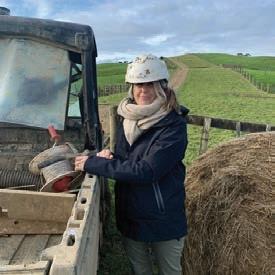
It was frustrating to occasionally run into people on the three farm blocks she owns with her husband William, and not know who they were and what they were doing.
“We used to have a box at the farm gate where people were supposed to sign in.
“It never happened. Not once.” This mattered a lot to the safety conscious couple. Karen says safety on the farms is forefront of mind on a daily basis because of the diversity and number of hazards.

The Zero Harm app is designed as a health and safety solution for challenging workplaces like farms and horticultural businesses

The Zero Harm app changed all that, and Karen and William now know exactly who is where because the app is an integral part of operations on their sheep, beef, deer and cropping farms run on three blocks. They have more than 23,000 stock units. Everyone –the owners, the five employees and the plethora of contractors who come on site – signs in, because it’s easy and just what people do.
All contractors have to download the app before entering the farms, and Karen can see whether they have done this. “Then when they get to my gate, they sign in to the app and they are in my system.
“Our contractors are really happy with the app.”
Crucially, like everyone else, they are aware of relevant hazards and dangers on the farms. Karen’s ‘go to’ example is the three-month-long roar when the stags’ paddocks are not safe places to be.
The Zero Harm app is designed as a health and safety solution for challenging workplaces like farms and horticultural businesses. Karen first got excited by the app’s potential after listening to an orchardist saying how great it was.
Inductions are only a few finger taps away and only unknown risks are displayed to maximise productivity. The app can include up-to-date health and safety policies. One of Karen’s favourite app features – “it’s awesome” – is the temporary hazards one which allows her to alert everyone to new dangers, such as the stags’ paddock, or tracks to avoid due to slippery conditions.
“Because everyone is signing in, and I get a notification, I have a full picture of who is doing what and where.”
Before the app, Karen says she had “a thousand pieces of paper flying around, and nothing really nailed what we were required to do”. The chat with the orchardist made her realise that she needed to digitise her systems and have all the farms’ health and safety information consolidated into the app.
“I’m not very techo, but I find the app so easy to use. I was probably an early adopter.”
Karen says someone getting hurt is her biggest fear. “If something did happen, then thanks to the app you have everything in one place. Everything I need is at my fingertips.”
Asked about tangible health and safety results from using the app, she says “well, nothing has happened”.
The ORCHARDIST : OCTOBER 2023 75 WHAT’S NEW
Karen Oliver on her Te Kuiti farm
Making work in horticulture safer

Horticulture New Zealand is co-funding a project with the ACC (Accident Compensation Corporation) through their Workplace Injury Prevention Grant to better understand causes of harm in horticulture and viticulture. Branded Grow Home Safe, the project is one of the initiatives run through Rebecca Fisher’s team at HortNZ.
Why is Grow Home Safe necessary?
If you don’t understand the problem, you can’t fix it. ACC data from the wider agricultural sector tells us rates of harm have been increasing in horticulture. Each year, around $18 million is paid out in horticulture-related ACC claims. Their data shows lumbar sprains, cuts to hands and fingers, and injuries to the back, shoulder, and eye are the most common in horticulture. We also know there are high levels of stress.
Do growers need to be doing more to keep staff safe?

We want to ensure Grow Home Safe is by industry, for industry. We know our growers are already doing great things to look after the health, safety and wellbeing of their teams, so we want to share the good work already
happening and work with industry to develop new initiatives where there are gaps. Grow Home Safe aims to provide growers with horticulturespecific knowledge to inform their risk management and business decisions, and tools and initiatives to help keep their people safe.
Are there industry safety standards?
We are partnering with Site Safe to develop foundation level health and safety training. By having industry standard training, employers can be confident that workers will have a base level of health and safety knowledge, making induction easier and ensuring a safer workforce. We have started developing this training with an industry-led steering group set up to ensure the training is fit-forpurpose and meets industry needs.
HORTICULTURE NEW ZEALAND
What’s next for Grow Home Safe?
We have worked with health and safety specialists IMPAC to develop horticulture-specific risk management training. Feedback from the pilot sessions show that growers love that the imagery, language and examples were all tailored to hort. It made sense to them, and they could see how to apply the concepts back on orchard and in the field. In October and November this is being rolled out as nine user-pays workshops in weather-affected regions of the North Island. See the website or contact us for details.
To find out more, visit: www.growhomesafe.co.nz or email: info@growhomesafe.co.nz
HortNZ advocates for and represents the interests of New Zealand’s 4200 commercial fruit and vegetable growers. HortNZ’s purpose is creating an enduring environment where growers thrive. HortNZ has 20 affiliated product groups and more than 30 affiliated local and regional grower associations. Find out more on www.hortnz.co.nz
Rebecca Fisher HortNZ general manager projects & programmes
76 The ORCHARDIST : OCTOBER 2023 FINAL PICK
Reaching all levy-paying fruit growers in New Zealand.



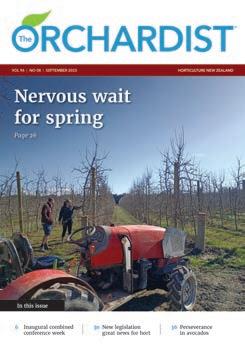
If it’s fresh produce in New Zealand, we have it covered.
Print
New Zealand resident: NZ$165 (GST inclusive)
Australia & Pacific:
NZ$280 (airmail delivery)
Rest of the World:
NZ$305 or US equivalent (airmail)
For information about how to subscribe please visit hortnz.co.nz/news-events-and-media/magazines

Rapid pest control. Better fruit!

Unique, fast acting and systemic control of codling moth, leaf roller caterpiller and bronze beetle in pipfruit.
• New chemistry with a unique spectrum of pest control
• Strong proven activity against all life stages of moths
• Fast cessation of feeding with systemic activity and excellent length of activity
• Soft on key beneficials Insist on Vayego from Bayer today!
We’re with you in the field | cropscience.bayer.co.nz

Registered pursuant to the ACVM Act 1997, No. P9623. See www.foodsafety.govt.nz for registration conditions. Approved pursuant to the HSNO Act 1996, No. HSR101424. See www.epa.govt.nz for approval conditions. Vayego® is a registered trademark of the Bayer Group. © Bayer Crop Science 2023.
BAC 2892 NE W
















 Glenys Christian
Glenys Christian








 Brussels sprouts being harvested on the Lilley farm 2 Max and Margaret Lilley (right) lunching with a Japanese Agricultural Exchange executive during a visit to Japan, at which the Lilleys were representing New Zealand growers 3 Max and Margaret Lilley (right) pictured during a visit to Japan with (centre) Akira Tanino,chairman of the Japanese Vegetable Supply Stabilisation Fund which was influential in the importation of vegetables, mainly onion and squash. To the right are flower growers from Hungary, and in the back row members of the Japanese Ministry of Agriculture and Japanese Vegetable Supply Stabilisation Fund 4 When Max Lilley first began growing broccoli, ‘icing’ to keep it fresh for transport
Brussels sprouts being harvested on the Lilley farm 2 Max and Margaret Lilley (right) lunching with a Japanese Agricultural Exchange executive during a visit to Japan, at which the Lilleys were representing New Zealand growers 3 Max and Margaret Lilley (right) pictured during a visit to Japan with (centre) Akira Tanino,chairman of the Japanese Vegetable Supply Stabilisation Fund which was influential in the importation of vegetables, mainly onion and squash. To the right are flower growers from Hungary, and in the back row members of the Japanese Ministry of Agriculture and Japanese Vegetable Supply Stabilisation Fund 4 When Max Lilley first began growing broccoli, ‘icing’ to keep it fresh for transport




































 Pacific Island Rugby organised the match, which revealed a remarkably high level of talent, spirit and pace
Pacific Island Rugby organised the match, which revealed a remarkably high level of talent, spirit and pace




 Aimee Wilson
Aimee Wilson
































 Dr Jim Walker, who has led Plant & Food Research industry engagement
Dr Jim Walker, who has led Plant & Food Research industry engagement




















 Shelly O’Shaughnessy is director of sales and support services for CHEP New Zealand
Shelly O’Shaughnessy is director of sales and support services for CHEP New Zealand







































 Ben Noll : National Institute of Water and Atmospheric Research (NIWA)
Ben Noll : National Institute of Water and Atmospheric Research (NIWA)

























